Posts Tagged ‘wildlife extinctions’
Monday, May 20th, 2013
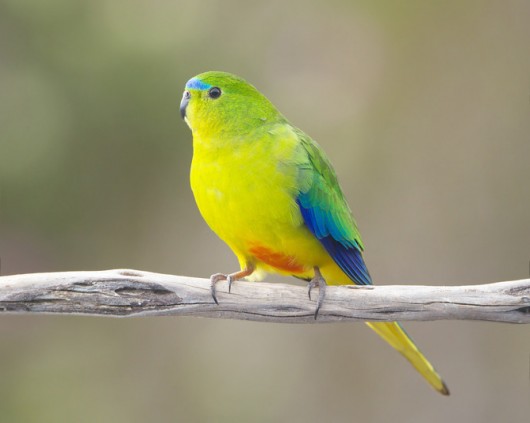 Orange-Bellied Parrot (Neophema chrysogaster)
Critically endangered and breeds only in Tasmania, Australia
[Source: Photo by John Harrison, in article ‘Threat of extinction demands fast and decisive action’, 20120724, by Tara Martin, published in The Conversation,
^http://theconversation.com/threat-of-extinction-demands-fast-and-decisive-action-7985] Orange-Bellied Parrot (Neophema chrysogaster)
Critically endangered and breeds only in Tasmania, Australia
[Source: Photo by John Harrison, in article ‘Threat of extinction demands fast and decisive action’, 20120724, by Tara Martin, published in The Conversation,
^http://theconversation.com/threat-of-extinction-demands-fast-and-decisive-action-7985]
.
Government Ecological Hypocrisy
.
While Australia’s governments at federal and state level continue to allow and encourage logging, burning and mining of Australia’s native forest ecosystems, many conservationists are well aware of that the loss of these forests habitats, and other human harmful actions are driving the extinction of Australia’s flora and fauna.
Threatened species can only be saved from extinction if first their habitat is properly protected from harm. Many species such as the Orange-Bellied Parrot which has now become critically endangered require more than just habitat protection, but active recovery intervention to save it from extinction. Yet this parrot species’ native habitats restricted to southern coastal Victoria and Tasmania are actively being destroyed as if government were sadistically and callously encouraging its extinction.
In governments we trust. Yet infamously in July 2009, the man who used to belt out “And the company takes what the company wants/And nothing’s as precious as a hole in the ground”, Midnight Oil’s Peter Garrett, as then entrusted Environment Minister, approved the Beverley Four Mile Uranium Mine in South Australia.
[Source: ‘Why Peter Garrett lost his way’, August, 2009, by David Glanz ^http://www.solidarity.net.au/best/why-peter-garrett-lost-his-way/]
.
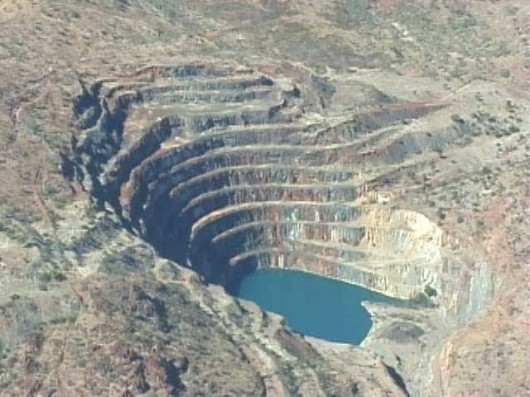 Beverley Four Mile Uranium Mine
550km north east of Adelaide Beverley Four Mile Uranium Mine
550km north east of Adelaide
.
At the most senior level, the Australian Government minister who is ultimately responsible and accountable to protect Australia’s natural ecology and to prevent flora and fauna extinctions, has his environment task diluted. Tony Burke MP is currently the Minister for (1) Sustainability (2) Environment (3) Water (4) Population (5) Communities (6) the Arts, which reflects the low value that the Australian Government places on protecting Australia’s Ecology.
 Australia’s recent Environment Ministers, respectively Peter Garrett and Tony Burke
Both Babyboomer Middle-Aged Men
Invariably in business, in politics, Babyboomer Middle-Aged Men
are the demographic drivers of ecological destruction across the planet. Australia’s recent Environment Ministers, respectively Peter Garrett and Tony Burke
Both Babyboomer Middle-Aged Men
Invariably in business, in politics, Babyboomer Middle-Aged Men
are the demographic drivers of ecological destruction across the planet.
.
Tony Burke has recently approved open coal mining that will destroy the Leard State Forest in New South Wales, remnant home of the increasingly rare Koala [^Read More].
Tony Burke has approved mining in Tasmania’s Tarkine (the last continuous wilderness region of Gondwana Rainforest home to more than 60 species of rare, threatened and endangered species including the Giant Freshwater Lobster, the Wedge Tailed Eagle, the Tasmanian Devil and the Orange-bellied Parrot [^Read More].
Tony Burke has recently approved logging to continue in recognised high conservation value native forests in Tasmania, previously agreed to be protected in an Intergovernmental Agreement between the federal and Tasmanian governments in Launceston on 7th August 2011 [^Read More].
Tony Burke has recently approved port development and shipping movements through the Great Barrier Reef for Rio Tintos’ bauxite mine in western Cape York, as well as a huge new coal export terminal at Abbot Point and at dredging of Gladstone Harbour despite the ongoing damage vital marine habitat supporting endangered species including turtles, dugongs and dolphins. [^Read More]
.
“For the powerful, crimes are those that others commit.”
~ Noam Chomsky, Imperial Ambitions: Conversations on the Post-9/11 World
.
 The 100 tonne coal ship the ‘Shen Neng 1’ which went aground on 5th April 2010, while negotiating the Great Barrier Reef
The ship destroyed 3km of the coral Douglas Shoal which it “completely flattened” and “pulverised” marine life. The marine park authority’s chief scientist, Dr David Wachenfeld, expressed concerned also about the toxic heavy metal anti-fouling paint scraping off the hull.
[Source: ‘Three kilometres of Great Barrier Reef damage, 20 years to mend’, 20100414, by Tom Arup, The Age newspaper,
^http://www.theage.com.au/environment/three-kilometres-of-great-barrier-reef-damage-20-years-to-mend-20100413-s7p8.html] The 100 tonne coal ship the ‘Shen Neng 1’ which went aground on 5th April 2010, while negotiating the Great Barrier Reef
The ship destroyed 3km of the coral Douglas Shoal which it “completely flattened” and “pulverised” marine life. The marine park authority’s chief scientist, Dr David Wachenfeld, expressed concerned also about the toxic heavy metal anti-fouling paint scraping off the hull.
[Source: ‘Three kilometres of Great Barrier Reef damage, 20 years to mend’, 20100414, by Tom Arup, The Age newspaper,
^http://www.theage.com.au/environment/three-kilometres-of-great-barrier-reef-damage-20-years-to-mend-20100413-s7p8.html]
.
Threatened Species Scientific Committee
– a toothless agency abused for ecopolitical spin
.
Then, at a lower level of government, a committee has been established since 2000 to advise Australia’s Environment Minister on issues associated with Australia’s increasing list of threatened species.
The Threatened Species Scientific Committee (TSSC) is legally established for under the Environment Protection and Biodiversity Conservation Act 1999 (EPBC Act), which superseded the 1992 Endangered Species Protection Act. The committee’s function is to advise the Minister for Sustainability, Environment, Water, Population and Communities (currentky Tony Burke MP) on:
- Amendments and updating of threatened species and threatened ecological communities lists
- Key Threatening Processes
- Preparing Species Recovery Plans and Threat Abatement Plans
- Scientific input into the Species Profile and Threats Database (^SPRAT)
- Advice on the presence of hybrids in listed ecological communities
- Hold periodic workshops dealing with issues concerning Australia’s threatened species and threatened ecosystems
.
Every year the committee publishes an annual report, except it has been six years since the Australian Government published one on its website. Here is the latest report from 2006-07. [>Read 2006-07 Report.pdf , 40kb) ]
.
[Source: ‘Threatened Species Scientific Committee’, ^http://www.environment.gov.au/biodiversity/threatened/committee.html]
.
Australia’s Threatened Fauna
.
As at the date of this article, the Australian Government lists the following statistics as our native fauna currently threatened with extinction to varying degrees, or now extinct.
Beware that government websites can change with whim and so the existence of the link below may disappear at any time.
.
Extinct:
- frogs (4)
- birds (23)
- mammals (27)
- other animals (1)
.
Extinct in the wild:
.
Critically Endangered:
- fishes (6)
- frogs (5)
- reptiles (4)
- birds (7)
- mammals (4)
- other animals (21)
.
Endangered:
- fishes (16)
- frogs (14)
- reptiles (16)
- birds (44)
- mammals (35)
- other animals (17)
.
Vulnerable:
- fishes (24)
- frogs (10)
- reptiles (36)
- birds (60)
- mammals (55)
- other animals (11)
.
Conservation dependent:
.
Total Threatened Fauna Species: (445)
.
[Source: Australia’s Threatened Flora, 2013, ^http://www.environment.gov.au/cgi-bin/sprat/public/publicthreatenedlist.pl]
.
Australia’s Critically Endangered Mammals
.
The above list is out of date, and the International Union for Conservation of Nature (IUCN) records are also out of date, because of the lack of diligent timely monitoring efforts by the Australian Government, and tardiness by the Australian Government in updating pertinent threatened species information back to the IUCN. Basically the Australian Government simply doesn’t care enough about Australian Ecology and dependent species about to become extinct.
It is a dire situation disgracefully detestable and sad.
According to an article in The Conversation back in December 2012, in respect to Australian mammal fauna, there are not four species deemed to be critically endangered to extinction, but now twelve, as listed below. Some of these may well be extinct such as the Christmas Island Pipistrelle..
The plight and demise of these species is not new. The Australian Government and its committees, reviews, reports and laws have confirmed this for many years. More committees, reviews, reports and laws equates to unforgiveable avoidance of moral and legal responsibility by the incumbent Environment Minister, this man:
.
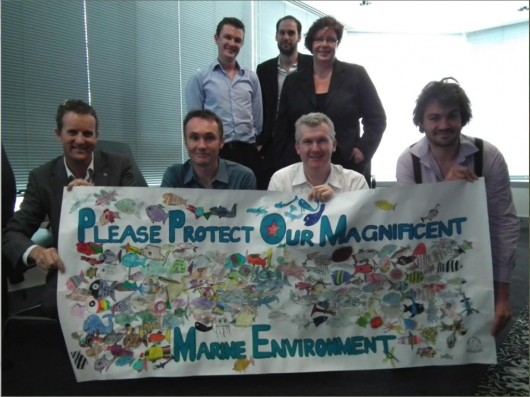 Tony Burke – the only grey haired Babyboomer in this photo
His demographic is responsible for the worst destruction of ecology across the Planet,
because the Nature-compromising values of males in this generation were formed when Nature was still considered plenty and its exploitation a God-given gospel.
Tony Burke’s values are wrong, inappropriate and his powerful decisions irreversible. Tony Burke – the only grey haired Babyboomer in this photo
His demographic is responsible for the worst destruction of ecology across the Planet,
because the Nature-compromising values of males in this generation were formed when Nature was still considered plenty and its exploitation a God-given gospel.
Tony Burke’s values are wrong, inappropriate and his powerful decisions irreversible.
.
- Woylie (Bettongia penicillata) also known as the Brush-tailed Bettong, or Brush-tailed Rat Kangaroo; a small marsupial found from south-west Western Australia across southern Australia.
- Mountain Pygmy Possum (Burramys parvus) – this tiny possum occurs as three isolated, genetically distinct populations in the alps of Victoria and NSW.
- Christmas Island Shrew (Crocidura trichura) – endemic to Christmas Island and hasn’t been seen since 1985. It is possibly extinct.
- Northern Hairy-nosed Wombat (Lasiorhinus krefftii) – approximately 200 of these wombats remain; they are limited to Epping Forest National Park (Scientific), and a reintroduced population at the Richard Underwood Nature Refuge, in Queensland.
- Lesser Stick-nest Rat (Leporillus apicalis) – this central-Australian rodent is probably extinct, with no reliable sightings since 1970.
- Bramble Cay (Melomys Melomys rubicola) – limited to a small cay in the Torres Strait, this rodent has one of the most restricted distributions of any mammal species.
- Lord Howe Long-eared Bat (Nyctophilus howensis) – known only from a single skull found in 1972, but Lord Howe Islanders continue to report bat sightings.
- Christmas Island Pipistrelle (Pipistrellus murrayi) – while listed as critically endangered, it’s generally accepted this little bat is now extinct.
- Gilbert’s Potoroo (Potorous gilbertii) – only 40 or so of these rabbit-sized marsupials live in south-west Western Australia, but the population seems stable.
- Kangaroo Island Dunnart (Sminthopsis aitkeni) – this little hand-sized marsupial is restricted to a very small area of Kangaroo Island.
- Carpentarian Rock Rat (Zyzomys palatalis) – a rodent found in sandstone gorges in the Northern Territory, there are thought to be less than 2000 remaining.
- Central Rock Rat (Zyzomys pedunculatus) – this rodent is found only in the western MacDonnell Ranges in the Northern Territory.
.
[Source: ‘Australia’s critically endangered animal species’, 20121206, by Jane Rawson, The Conversation, ^http://theconversation.com/australias-critically-endangered-animal-species-11169]
.
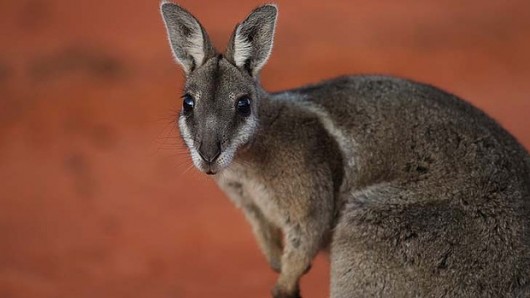 On the brink of extinction: the Bridled Nailtail Wallaby
[Source: Photo by Kate Geraghty, Dead and dying: our great mammal crisis’, 20121117, by Tim Flannery, The Age newspaper,
^http://www.theage.com.au/national/dead-and-dying-our-great-mammal-crisis-20121116-29hi9.html] On the brink of extinction: the Bridled Nailtail Wallaby
[Source: Photo by Kate Geraghty, Dead and dying: our great mammal crisis’, 20121117, by Tim Flannery, The Age newspaper,
^http://www.theage.com.au/national/dead-and-dying-our-great-mammal-crisis-20121116-29hi9.html]
.
Leadership, Accountability, Timely Action
.
According to Tara Martin, Research Scientist at Ecosystem Sciences at the CSIRO:
<<When it comes to mammal extinctions, Australia’s track record over the last 200 years has been abysmal. Since European settlement, nearly half of the world’s mammalian extinctions have occurred in Australia – 19 at last count. So, when faced with the additional threat of climate change, how do we turn this around and ensure the trend doesn’t continue?
Learning from previous extinctions is a good place to start. A comparison between two Australian species, the recently extinct Christmas Island pipistrelle and the critically endangered but surviving orange-bellied parrot, provides some insight into the answer to this question. Namely, that acting quickly and decisively in response to evidence of rapid population decline is a key factor in determining the fate of endangered species.
.
‘Government Delay condemn a species to extinction’
A Case of Government Delay:
.
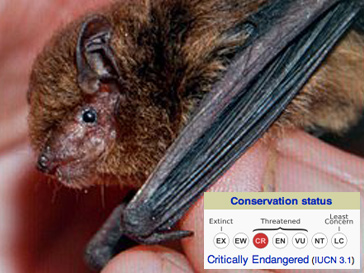 Species Extinction on Peter Garrett’s Watch
<< The Australian Government will invest $1.5 million to begin the rescue of Christmas Island’s ecosystem, including a mission to capture the last remaining Pipistrelle bats for captive breeding. “Volunteers and help from the Australasian Bat Society will be invaluable in this capture effort.” “My top priority now is to prevent any further extinctions and to restore the island’s environmental health,” Mr Garrett said.>>
A year later the critically endangered Christmas Island Pipistrelle (Pipistrellus murrayi) was declared extinct. Species Extinction on Peter Garrett’s Watch
<< The Australian Government will invest $1.5 million to begin the rescue of Christmas Island’s ecosystem, including a mission to capture the last remaining Pipistrelle bats for captive breeding. “Volunteers and help from the Australasian Bat Society will be invaluable in this capture effort.” “My top priority now is to prevent any further extinctions and to restore the island’s environmental health,” Mr Garrett said.>>
A year later the critically endangered Christmas Island Pipistrelle (Pipistrellus murrayi) was declared extinct.
[Source: ‘Christmas Island Pipistrelle Rescue’, 20090703, by Bat Conservation & Rescue Qld Inc., ^http://www.bats.org.au/?p=710]
.
<<Endemic to Christmas Island, the pipistrelle was a tiny (3.5 gram) insect-eating bat. It was first described in 1900, when numbers were widespread and abundant. In the early 1990s this began to change. The decline was rapid and the exact cause uncertain.
By 2006, experts were calling for a captive breeding program to be initiated. These pleas were ignored until 2009 when it was finally given the green light. Sadly the decision came too late, and two months (the then Minister for the Environment, Heritage and the Arts, Peter Garrett MP) announced that the rescue attempt had failed.>>
.
A Case of Government Action (so far):
.
<<Concern about the orange-bellied parrot began in 1917, but it wasn’t until 1981 that it was confirmed to be on the brink of extinction. In an attempt to save the parrot, a multi-agency, multi-government recovery team was set up and a captive breeding program began in 1983.
Like the bat, threats to the parrot remain poorly understood. In 2010, monitoring showed that the species would become extinct in the wild within three to five years unless drastic action was taken. The recovery team immediately took action to bolster the captive population as insurance against extinction. There are currently 178 birds in captivity and less than 20 in the wild.
.
<<…How we manage endangered species ultimately comes back to the decisions made, including who makes the decisions, who is held accountable, and the timing of these decisions.
Examining these cases in the context of decision-making reveals some clear differences and highlights some important recommendations for the future management of endangered species.
One of the key differences was in the governance and leadership surrounding the two cases. Experts involved in monitoring the pipistrelle provided recommendations to government bodies, but did not have the authority to make decisions nor was there an effective leader to champion the urgent need to act. Conversely, the Orange-bellied Parrot Recovery Team had the authority to make decisions and act on them. Indeed, thanks to the Recovery Team’s broad representation, any failure to act would likely have resulted in public outcry – which raises the issue of accountability.
Management of endangered species requires tough decisions, yet they are decisions we must make. If we monitor declining populations without a process for deciding between different management options, we will only document extinctions. In some cases, the logical decision may be to employ a triage system where priority is given to species with a high likelihood of recovery. Assigning institutional accountability around the management of endangered species could help to ensure that tough decisions are made and that the processes involved are transparent.
Finally, the cases of the bat and the parrot also highlight the need to act quickly when a species is found to be on the brink of extinction. Delaying decisions only narrows our choices and removes opportunities to act. We may not always have all the answers, but this cannot be used as a reason to delay decision making. Based on a triage system a decision to not to act might be the best way forward, but if we delay the decision it becomes the only way forward.
..scientific analysis can be used to determine how much information we need to inform a good conservation decision. In the case of the Christmas Island pipistrelle, the decision to start a captive breeding program came many years too late.
By evaluating the costs, benefits, and feasibility of taking different management actions in the light of what we know about a species’ decline (or don’t know – i.e. the degree of uncertainty), it is possible to get the timing right.
Research into the methods used to stem species decline is also underway. For example, captive breeding and reintroduction programs are generally regarded as having good success rates. Further investigation into genetic management, habitat restoration, and effective techniques for reintroduction and risk management will help ensure the success of these programs for a variety of species.
Stemming the global loss of biodiversity through Species Recovery Planning will require brave decision-making in the face of uncertainty. Monitoring must be linked to decisions, institutions must be accountable for these decisions and decisions to act must be made before critical opportunities, and species, are lost forever.>>
.
[Source: ‘Threat of extinction demands fast and decisive action’, 20120724, by Tara Martin, Research Scientist, Ecosystem Sciences at CSIRO, (based on a paper by Tara Martin and with input from co-authors Mark Holdsworth, Stephen Harris, Fiona Henderson, Mark Lonsdale, in The Conversation, ^http://theconversation.com/threat-of-extinction-demands-fast-and-decisive-action-7985]
.
.
Principles to Properly Protect Threatened Species
.
The Australian Government is accountable for the conservation of Australia’s natutral environment and dependent species, particularly those at risk of extinction. It is charged with the democratic authority to do so and the Australian people entrust it to act responsibly. The Australian Government since 1999 had in place a national law protecting threatened species under its Environment Protection and Biodiversity Conservation Act, and since 2000 had an expert Threatened Species Scientific Committee advising it on priorities for threatened species and key threatening processes and recommended conservation actions.
But having a framework for conservation action is two steps short of the conservation action itself. Without proper funding and timely onground action, government environmental conservation is but hypocritcal lip service.
.
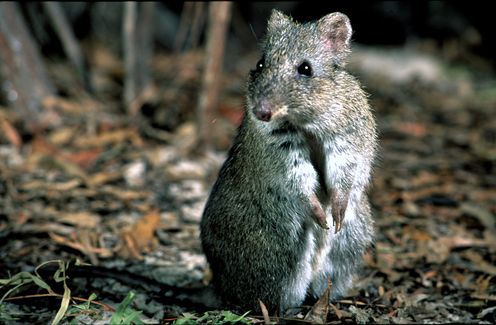 Gilbert’s Potoroo – only 40 left Gilbert’s Potoroo – only 40 left
.
2008 Review of Threatened Species Protection
.
Section 522A of the EPBC Act requires it to be reviewed every 10 years from its commencement. So on 31 October 2008, Peter Garrett MP as the then Minister for the Environment, Heritage and the Arts, commissioned an independent review of the Environment Protection and Biodiversity Conservation Act 1999 (EPBC Act), the Australian Government’s central piece of environmental legislation.
The Terms of Reference were:
- the operation of the EPBC Act generally
- the extent to which the objects of the EPBC Act have been achieved
- the appropriateness of current matters of National Environmental Significance
- the effectiveness of the biodiversity and wildlife conservation arrangements
- Seek input from state and territory governments, members of the community and industry
.
The review to be guided by key Australian Government policy objectives:
- To promote the sustainability of Australia’s economic development to enhance individual and community well-being while protecting biological diversity and maintaining essential ecological processes and systems
- To work in partnership with the states and territories within an effective federal arrangement
- To facilitate delivery of Australia’s international obligations
- The Australian Government’s deregulation agenda to reduce and simplify the regulatory burden on people, businesses and organisations, while maintaining appropriate and efficient environmental standards
- To ensure activities under the Act represent the most appropriate, efficient and effective ways of achieving the Government’s outcomes and objectives in accordance with the Expenditure Review Principles.
.
The review was undertaken by Dr Allan Hawke (government representative) supported by a panel of experts- a retired NSW judge Paul Stein AM, Professor Mark Burgman (Environmental Science), Professor Tim Bonyhady (Environmental Law), Rosemary Warnock (ethical standards and the environment).
Community participation in the review was encouraged and 220 written submissions were received and 140 face-to-face consultation meetings were held in capital cities around Australia. An Interim Report on the review was released and a further 119 written comments were received. The Final Report was delivered to the Minister on 30 October 2009 and publicly released on 21 December 2009.
On 24 August 2011, the Minister released the Australian Government response to the independent review, three years after the review process began and about a year after the ten year review deadline.
The response centred around four key themes:
- Abandonning targeted actions to save critically endangered threatened species, and instead to vague “strategic approaches” and more plans
- Simplification of the assessment and approval processes for threatened species – vague, cheaper and less research work
- Big picture ecosystem approach
- Compromise of national standards to “harmonise” conservation approaches with the States having different priorities
.
Irrespective of the 220 written submissions and 140 face-to-face consultation meetings, out of the 71 recommendations in the Final Report, the Australian Government agreed either in part, in principle, in substance, but has since done precious little to protect Australia’s threatened species.
The review process was stipluated in the EPBC Act, but all it achieved was an opportunity for the Australian Government to undermine the 1999 standards, water down national environmental protection legislation, simplify the government’s administration and save money. Effectively the EPBC Review was a bureacratic talk fest and an expensive waste of time and taxpayer money that would have been better spent on implementing known critically endengerd species and their habitats.
The survival of Australia’s threatened species remain at the whim of federal and state governments.
What did the entire review process cost including the consultants? The amount is secret. Was it $10 million, more? The estimated cost of a Species Recovery Plans and Threat Abatement Plan to save the critically endangered Orange-bellied Parrot is how much?
Meanwhile, as few as 250 Orange-bellied Parrots remain in existence, making the species one of the most endangered species on the planet.
Meanwhile, community volunteers with The Friends of the Orange-Bellied Parrot and Wildcare Inc. in Tasmania continue to monitor the Orange-bellied Parrots during their breeding season in far southwest Tasmania’s Wilderness World Heritage Area. Members live for periods of 10 days at Birch Inlet and Melaleuca in Tasmania’s Wilderness World Heritage Area, making observations of the daily lives of the OBPs, including birds that have been bred in captivity and released at the beginning of the season as part of the Species Recovery Plan for the Orange-Bellied Parrot.
They don’t get money from the Australian Government and so have set up the Save the Orange-bellied parrot Fund. Wildcare Inc volunteers receive a small reimbursement allowance from the Tasmanian Government’s watered down Department of (1) Primary Industries, (2) Parks, (3) Water and oh yeah (4) Environment to assist with their costs.
.
[Source: Wildcare Incorporated, Tasmania, ^http://www.wildcaretas.org.au/]
.
.
.
.
.
[Source: Australian Government, ^http://www.environment.gov.au/epbc/review/]
.
2012 Review of Threatened Species Protection
.
After the entire the EPBC Act Review process and a year after the Australian Government’s response to it, on 31 October 2012 the Australian Senate this time set up yet another review into the Effectiveness of Threatened Species and Ecological Communities’ Protection in Australia. It commissioned a Senate Standing Committee on Environment and Communications for enquiry and report.
This second review process came in light of the rubber stamp realisation by The Greens Senator Larissa Waters of how the Australian Government had poorly treated the EPBC Review and in light of the Auditor General report that Victoria’s environment and primary industry departments are failing to act as proper watchdogs [^Read More]. Further to that we’ve seen Professor Tim Flannery publish his opinion piece (from the Monthly’s Quarterly Essay) on the extinction crisis pointing some of the blame at the Commonwealth’s inaction [^Read More].
Public submissions were to be received by 14th December 2012 and the reporting date scheduled to be 7th February 2013, but rather late again on 14th May 2013, the Senate granted an extension of time for reporting until 20 June 2013 (one month’s time from the date of this article).
The Terms of Reference are:
(a) Management of key threats to listed species and ecological communities
(b) Development and implementation of Species Recovery Plans
[Ed: About time, and what about commensurate Threat Abatement Plans? One is ineffective without the other.]
(c) Management of critical habitat across all land tenures
(d) Regulatory and funding arrangements at all levels of government
(e) Timeliness and risk management within the listings processes
(f) The historical record of state and territory governments on these matters
(g) Any other related matter.
.
[Sources: ‘The effectiveness of threatened species and ecological communities’ protection in Australia’, Terms of Reference, Australian Senate,^http://www.aph.gov.au/Parliamentary_Business/Committees/Senate_Committees?url=ec_ctte/threatened_species/tor.htm; ‘Threatened species in the senate spotlight’, 20121121, Councillor Samantha Dunn, Shire of Yarra Ranges, Victoria, Australia (website), ^http://crdunn.blogspot.com.au/2012/11/threatened-species-in-senate-spotlight.html]
.
Public submissions received by the Senate Committee
.
1 Mr Gabriel Lafitte (PDF 39KB)
2 Dr Todd Soderquist and Dr Deborah Ashworth (PDF 41KB) Attachment 1(PDF 395KB)
3 Mr Marcus Coghlan (PDF 91KB)
4 Australasian Native Orchid Society and the Australian Orchid Council (PDF 309KB)
5 Ms Fay Jones (PDF 4KB)
6 Monaro Acclimatisation Society Inc (PDF 267KB)
7 Mr James Samargis (PDF 56KB)
8 Mr Stephen Chara (PDF 432KB), Supplementary Submission(PDF 1213KB)
9 Mr Sab Lord, Lords Kakadu and Arnhemland Safaris (PDF 9KB)
10 Ms Kylie Jones (PDF 43KB)
11 East Gippsland Wildfire Taskforce Inc (PDF 1483KB)
12 Regent Honeyeater Project (PDF 9KB) Attachment 1(PDF 2946KB)
13 Mr Rob Brewster (PDF 2063KB)
14 Mr Tom Kingston (PDF 16KB)
15 Professor David Lindenmayer (PDF 44KB)
16 Mr Frank Manthey OAM, Save the Bilby Fund (PDF 189KB), Supplementary Submission(PDF 1154KB)
17 Friends of Tootgarook Wetland Reserves (PDF 390KB)
18 Mr Jim Walker (PDF 193KB)
19 Ms Harriett Swift (PDF 34KB), Supplementary Submission(PDF 11KB)
20 Island Conservation (PDF 1011KB)
21 Wildflower Society of Western Australia (Inc) (PDF 161KB)
22 Mr Daniel Bell (PDF 11KB)
23 Marie-Louise Sarjeant, Chris Sarjeant, Sonia Hutchinson, John Marsh, Maxine Jacobsen, Diana Kellett, Lesley Palma (PDF 945KB)
24 Save Tootgarook Swamp Inc (PDF 1777KB)
25 Ms Joan Spittle (PDF 83KB)
26 Mr John Jeayes (PDF 431KB)
27 Zoo and Aquarium Association (PDF 57KB)
28 Ray and Marion Lewis (PDF 239KB)
29 Mr Jean Dind (PDF 32KB)
30 Associate Professor Adrian Manning (PDF 97KB) Attachment 1(PDF 370KB), Supplementary Submission(PDF 167KB)
31 Port Campbell Community Group Inc (PDF 152KB)
32 Mr Philip Collier (PDF 790KB)
33 Mr Trevor Parton (PDF 58KB)
34 Mr Ian Wheatland, Mr Kai May, Dr Katherine Phillips and Mrs Nina Kriegisch (PDF 126KB)
35 Ms Susan M Broman (PDF 890KB)
36 Sister Marian McClelland sss (PDF 29KB)
37 Finch Society of Australia Inc (PDF 65KB)
38 Clarence Valley Conservation Coalition (PDF 250KB)
39 Ms Mary White rsm (PDF 273KB)
40 Ms Marie Hilarina Fernando (PDF 103KB)
41 Dr Emma Rooksby and Dr Keith Horton (PDF 63KB)
42 Zoos Victoria (PDF 240KB)
43 The Colong Foundation for Wilderness (PDF 376KB)
44 Mr Stewart Kerr (PDF 5KB)
45 Mr Peter Berbee (PDF 24KB)
46 Dr Andrew Burbidge (PDF 69KB)
47 Name Withheld (PDF 45KB)
48 Professor John Woinarski (PDF 157KB)
49 Ms Lee Curtis (PDF 100KB)
50 Mr Thomas Weiss (PDF 36KB)
51 Dr Peter Kyne (PDF 387KB)
52 Dr Greg P Clancy (PDF 218KB)
53 Mr Trent Patten (PDF 1536KB)
54 Ms Sabine Ritz-Kerr (PDF 47KB)
55 Dr Martine Maron (PDF 196KB)
56 Ms Claire Masters (PDF 39KB)
57 The Wentworth Group of Concerned Scientists (PDF 2022KB)
58 Mr Jonathan Meddings (PDF 817KB)
59 Mr Nigel Sharp (PDF 329KB)
60 Assoc Prof Mark Lintermans (PDF 54KB)
61 Ms Pamela J W Miskin (PDF 66KB)
62 South East Forest Rescue (PDF 646KB)
63 Clarence Environment Centre (PDF 137KB)
64 Mr Craig Thomson (PDF 116KB)
65 Ms Peta Whitford (PDF 222KB)
66 Mr Daryl Dickson, Wildcard Art, Mungarru Lodge Sanctuary (PDF 269KB)
67 Ms Sera Blair (PDF 349KB)
68 Ms Kerryn Blackshaw (PDF 5KB)
69 Yarra Ranges Council (PDF 107KB)
70 Lawyers for Forests (PDF 1159KB)
71 Name Withheld (PDF 23KB)
72 Mr Greg Miles (PDF 157KB) Attachment 1(PDF 600KB) Attachment 2(PDF 4770KB)
73 Bendigo and District Environment Council, Bendigo Field Naturalists Club and Bendigo Sustainability Group (PDF 364KB) Attachment 1(PDF 173KB) Attachment 2(PDF 1923KB)
74 Dr Jasmyn Lynch (PDF 80KB)
75 Blue Mountains Conservation Society (PDF 202KB)
76 Wildlife Preservation Society of Queensland (PDF 246KB)
77 CSIRO (PDF 284KB)
78 Dr Chris McGrath (PDF 245KB)
79 Mr David Blair (PDF 195KB)
80 Name Withheld (PDF 183KB)
81 WWF-Australia (PDF 553KB) Attachment 1(PDF 378KB) Attachment 2(PDF 204KB)
82 BirdLife Australia (PDF 715KB) Attachment 1(PDF 1129KB)
83 Australian Deer Association (PDF 732KB)
84 LIV Young Lawyers’ Section, Law Institute of Victoria (PDF 1209KB) Attachment 1(PDF 4436KB) Attachment 2(PDF 1303KB), Supplementary Submission(PDF 335KB)
85 Stanislaw Pelczynski and Barbara Pelczynska (PDF 245KB)
86 Friends of Grasslands (PDF 100KB)
87 Dr Kerryn Parry-Jones (PDF 239KB) Attachment 1(PDF 2143KB)
88 Humane Society International (PDF 550KB)
89 Mr Jeremy Tager (PDF 1441KB), Supplementary Submission(PDF 185KB)
90 Ms Karena Goldfinch (PDF 141KB)
91 Mr Ray Strong (PDF 95KB)
92 Healesville Environment Watch Inc, MyEnvironment Inc and Friends of Leadbeater’s Possum Inc (PDF 2435KB)
93 Mr Ian Whitford (PDF 226KB)
94 Greenfleet (PDF 105KB)
95 Mr Barry Rowe, Candlebark Community Nursery Inc (PDF 178KB)
96 Conondale Range Committee (PDF 156KB)
97 Dr John Clulow (PDF 61KB)
98 Ms Melinda Taylor (PDF 73KB)
99 Mr David Hudson (PDF 78KB)
100 Ms Yasmin Kelsall (PDF 340KB)
101 S. Burgess and E. Bradley (PDF 61KB)
102 Ms Glenda Pickersgill (PDF 86KB)
103 Dr Tanzi Smith (PDF 249KB)
104 The Greater Mary Association Inc. (PDF 234KB)
105 Mr Philip Rance (PDF 651KB)
106 Caldera Environment Centre (PDF 416KB)
107 Mr Bruce Boyes (PDF 1505KB)
108 Australian Wildlife Health Network (PDF 418KB)
109 Friends of Hoddles Creek (PDF 1403KB)
110 Australasian Bat Society Inc (PDF 413KB)
111 Confidential
112 Confidential
113 Canberra Ornithologists Group (PDF 229KB)
114 Urban Bushland Council WA Inc (PDF 112KB)
115 MRCCC (PDF 559KB)
116 Threatened Ecosystems Network (PDF 1606KB)
117 Wildlife Disease Association Australasia (PDF 71KB)
118 Name Withheld (PDF 237KB)
119 Mr Andrew Heaver (PDF 126KB)
120 Name Withheld (PDF 76KB)
121 Ms Kate Leahy (PDF 35KB)
122 Dr Jonathan Rhodes (PDF 68KB)
123 Professor Lee Godden and Professor Jacqueline Peel (PDF 136KB) Attachment 1(PDF 123KB) Attachment 2(PDF 327KB)
124 Earth Learning Incorporated (PDF 352KB)
125 NSW Council of Freshwater Anglers (PDF 671KB)
126 Mr Mark Selmes (PDF 141KB)
127 Professor Hugh Possingham and Associate Professor Michael McCarthy (PDF 102KB)
128 Ms Susan Bendel (PDF 99KB)
129 The Wilderness Society Inc (PDF 68KB)
130 Minister for Environment and Heritage Protection Queensland (PDF 3463KB)
131 Ms Lorraine Leach (PDF 293KB)
132 Dr John Bardsley (PDF 1070KB)
133 Mr Wayne Gumley (PDF 144KB)
134 Nature Conservation Council of NSW (PDF 783KB)
135 Middle Kinglake Primary School (PDF 2301KB)
136 The Judith Eardley Save Wildlife Centre (PDF 1595KB)
137 Australian Network of Environmental Defender’s Offices Inc (PDF 214KB) Attachment 1(PDF 1129KB)
138 Ms Jenifer Johnson (PDF 1917KB)
139 Batwatch Australia (PDF 270KB)
140 Invasive Species Council (PDF 421KB)
141 Dr Rupert Baker (PDF 50KB)
142 National Parks Australia Council (PDF 331KB) Attachment 1(PDF 734KB) Attachment 2(PDF 3164KB)
143 Department of Sustainability Environment Water Population and Communities (PDF 1098KB)
144 Director of National Parks (PDF 249KB)
145 National Parks Association of NSW (PDF 196KB)
146 Mr Don Butcher (PDF 694KB)
147 Australian Conservation Foundation (PDF 725KB) Attachment 1(PDF 1129KB)
148 Australian Fisheries Management Authority (PDF 638KB)
149 Environment East Gippsland Inc. (PDF 2834KB)
150 Nature Conservation Society of South Australia (PDF 196KB)
151 Arid Lands Environment Centre (PDF 182KB)
152 Ms Prue Acton (PDF 394KB)
153 Ms Bronwyn Baade (PDF 55KB)
154 Threatened Species Scientific Committee (PDF 255KB)
155 VETO (VETO Energex Towers Organisation) (PDF 1695KB) Attachment 1(PDF 199KB)
156 Gecko – Gold Coast and Hinterland Environment Council and Save Bahrs Scrub Alliance (PDF 508KB) Attachment 1(PDF 569KB)
157 Threatened Plant Action Group (TPAG), Nature Conservation Society of South Australia (PDF 332KB)
158 FrogWatch (PDF 121KB)
159 Department of Land Resource Management, Northern Territory Government (PDF 8000KB)
160 Wildlife Preservation Society of Queensland, Gold Coast and Hinterland Branch (PDF 202KB)
161 North Coast Environment Council (PDF 594KB) Attachment 1(PDF 3788KB) Attachment 2(PDF 1914KB)
162 Australian Wildlife Conservancy (PDF 400KB) Attachment 1(PDF 637KB) Attachment 2(PDF 433KB)
163 MyEnvironment Inc (PDF 6137KB)
164 South East Region Conservation Alliance Inc (PDF 3514KB)
165 Logan and Albert Conservation Association (PDF 306KB) Attachment 1(PDF 197KB) Attachment 2(PDF 147KB)
166 PGV Environmental (PDF 916KB)
167 National Farmers’ Federation (PDF 61KB)
168 Wide Bay Burnett Enviroment Council (PDF 1311KB)
169 Premier of Western Australia (PDF 14211KB)
170 Confidential
171 Confidential
172 The Wilderness Society Victoria Inc (PDF 1182KB), Response from VicForests, dated 29 January 2013(PDF 78KB)
173 Brisbane Region Environment Council (PDF 965KB)
174 North East Forest Alliance (PDF 2272KB), Response from Forestry Corporation, NSW(PDF 2036KB)
175 Eagle Junction State School (PDF 12260KB)
176 Hunter Bird Observers Club (PDF 387KB)
177 Ms Margaret Peachey (PDF 63KB)
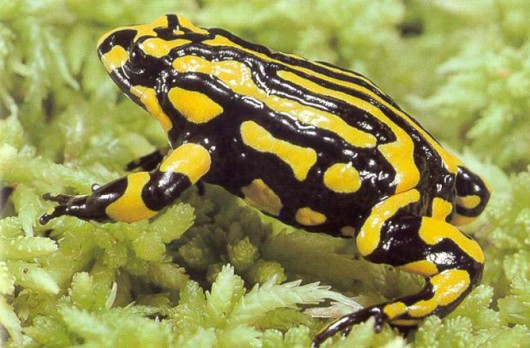 Southern Corroborree Frog (Pseudophryne corroboree)
Endemic to yet critically endangered in the Australian Alps. Southern Corroborree Frog (Pseudophryne corroboree)
Endemic to yet critically endangered in the Australian Alps.
Its demise has been directly caused by habitat destruction from recreational 4WD use, development of ski resorts,
introduced feral animals and human degradation of the frogs’ habitat.
As of June 2004 it was estimated to have a population of just 64.
.
Submission #82 by BirdLife Australia
.
Australia’s leading independent conservation advocate for native birds and their habitats, BirdLife Australia, has its own Threatened Species Committee. In its submission to the review, BirdLife Australia called on Australia’s national environment law, the EPBC Act, to:
.
-
Be accountable
-
Be transparent
-
Deliver on our international commitments
-
Specify measurable ecological outcomes
-
Have a mandate to intervene on matters that are national in scope
-
Be resourced and enforced
-
Give the Australian Community a voice on national environmental matters
-
Be based on independent advice
.
Specifically these were its recommendations in detail:
.
Be accountable
.
a. The Act should require that national environmental accounts are developed (Recommendation 67), produced annually, and include Matters of National Environmental Significance (MNES). Within this the IUCN Red List Index could be used to provide a measure of performance in the threatened species protection and management.
b. The Act should establish an Independent Environment Commission to provide objective, science-based advice to the Minister to improve decision-making and ensure greater transparency and accountability (Recommendation 71). The Commission should be responsible for independent monitoring, audit, compliance and enforcement activities under the Act.
c. The Act should prescribe mandatory decision-making criteria for ecological outcomes (Recommendation 43). All actions should be legally required to maintain or improve ecological outcomes, or to demonstrate a net improvement in national environmental accounts (for each relevant MNES).
d. Regional Forest Agreements require an independent review and a more rigorous approach to auditing. A process for public input and sanctions for serious non-compliance are required. The full protections of the Act should apply to forest activities where the terms of the RFAs are not being met (Recommendation 38).
.
Be transparent
.
a. Transparency in decision-making must be maintained and improved. Current proposals do not go far enough, for example statements of reasons for all decisions made by the Minister and delegates under the Act should be released at time of the decision (Recommendation 44(1)(c)).
b. The Act must provide greater access to the courts for public interest litigation. The Government’s Rejection of Recommendations 48-53 is a key failure of the Government’s response to provide suitable checks and balances for proposals to “streamline” processes.
c. A core element of Hawke’s reform package was to provide for environmental performance audits and inquiries. The Australian Government should be subject to regular environmental performance audit under a new specialist Environmental Performance Audit Unit in the Australian National Audit Office, provided for under the Auditor-General Act 1997.
.
Deliver on our international commitments
.
a. Critical habitat must be protected, with impacts on critical habitat equated to impact on species, and consideration given to the critical habitat required under climate change (Recommendation 12 (1)). However we feel that the critical habitat register should be retained and its remit expanded.
b. The Environment Minister requires powers to develop and implement management plans to protect the values of World Heritage properties, National Heritage Places and Ramsar wetlands where the collaborative processes have not produced effective plans (Recommendation 34).
.
Specify measurable ecological outcomes
.
a. The Act should specify required ecological outcomes. This could be delivered through specified reporting periods for MNES, such as on Species Recovery Plans and Threat Abatement Plans to ensure accountability. The Government agreed the Act should include provisions that enable the auditing of environmental outcomes (performance audits) (Recommendation 61).
.
Have a mandate to intervene on matters that are national in scope
.
a. The primary object of the Act should be ‘to protect the environment’ (Recommendation 3).
b. The Act, and the way it is administered, needs to better reflect the principles of Ecological Sustainable Development (Recommendation 2).
c. The process proposed in the Government response for listing ecosystems of national significance under the Act is too restrictive and inflexible.
d. The National Reserve System should be included as a MNES.
.
Be resourced and enforced
.
a. Cost recovery mechanisms under the Act are needed to ensure that the Environment Department is adequately resourced to ensure operation of the Act and monitor performance (Recommendation 62).
b. A Reparation fund should be established (Recommendation 60). Give the Australian Community a voice on national environmental matters
a. We strongly support the creation of a call in power for ‘plans, policies and programs’ that may have a significant impact on a MNES to better deal with cumulative impacts.
.
Be based on independent advice
a. The quality of Environmental Impact Assessment (EIA) information needs to be substantially improved. An industry Code of Conduct for consultants supplying information for EIA and approval under the Act should be developed and the Minister, or the Environment Commission, should audit assessment information (including protected matters) to test assertions made in EIAs (Recommendation 24).
b. The Environment Commission should also be tasked with establishing a process to free consultants from their commercial dependency on proponents.
.
[Source: ‘Submission to the Australian Senate Standing Committees on Environment and Communications entitled ‘The effectiveness of threatened species and ecological communities’ protection in Australia’, 20130308, by Professor Stephen Garnett(Coordinator – BirdLife Australia’s Threatened Species Committee) and Samantha Vine (Head of Conservation – BirdLife Australia, ^http://birdlife.org.au/].
.
 Margaret River burrowing crayfish (Engaewa pseudoreducta)
[© Photo by Quinton Burham]
With only two known populations, the Margaret River burrowing crayfish is highly endangered.
Even one of these may no longer exist, as there have been no sightings since 1985.
The threats are almost all attributed to human activity.
Land clearing is the biggest danger, as crayfish habitat can be eroded or contaminated by farming, mining and urban development.
Feral pigs also damage habitat.
[Source: ^http://www.australiangeographic.com.au/journal/australias-most-endangered-species.htm] Margaret River burrowing crayfish (Engaewa pseudoreducta)
[© Photo by Quinton Burham]
With only two known populations, the Margaret River burrowing crayfish is highly endangered.
Even one of these may no longer exist, as there have been no sightings since 1985.
The threats are almost all attributed to human activity.
Land clearing is the biggest danger, as crayfish habitat can be eroded or contaminated by farming, mining and urban development.
Feral pigs also damage habitat.
[Source: ^http://www.australiangeographic.com.au/journal/australias-most-endangered-species.htm]
.
Submission #85 by our regular contributors
.
<<We acknowledge the Indigenous Nations of Australia as the traditional owners of its land and waters. We thank them for the ecological wisdom they did and continue to pass to us.
We have read and agree with the contents of the two submissions to the Committee from Marie-Louise Sarjeant, Chris Sarjeant, Sonia Hutchinson, John Marsh and Maxine Jacobson, and from Wendy Radford for BDEC, Stuart Fraser for BFNC and Sara Hill and wish to take this opportunity to register with the Committee our endorsement of them.
.
Introduction
.
<<When about 50 years ago we became involved in environmental issues, we never thought that we will be witnessing in our lifetime the degree of environmental degradation we are witnessing now.
The rate at which the degradation is now occurring is very alarming, as given that global warming and loss of biodiversity exacerbate each other, there is a real possibility that unless we act now, this positive feedback cycle will escalate beyond our ability to prevent it from resulting in the collapse of our life supporting natural ecosystems.
Over the last 20 years that we lived on a property in the forest near Bendigo we personally witnessed the progressive local extinction of the swamp wallaby due to road kills, loss of habitat to development, degradation of the Greater National Park due to fuel reduction burns and weed infestation, including invasive plants escaping from ornamental gardens, replacement of native trees in Bendigo’s streetscapes with exotics and escalation of a thriving population of Indian mynas – and all this, in spite of the biodiversity strategies, environmental protection legislations and scores of submissions, Panel and VCAT hearings.
Why is it then that we are failing to provide effective protection to our biodiversity?
In this submission we will list some of the reasons for this failure.
.
Evidence of the ineffectiveness of threatened species and ecological communities’ protection in Australia
.
The ineffectiveness of threatened species and ecological communities’ protection is evident from the Natural Heritage Trust’s “Australian Terrestrial Biodiversity Assessment 2002” report and from the successive “State of the Environment” reports which show that all the important environmental indicators are getting worse.
The reasons for this ineffectiveness is:
.
Promotion of populations growth
.
Concerns about the unsustainability of population growth and its impact on the natural environment is very well documented (Bartlett 1998, Catton 1982, Lowe 2005, p 59, Suzuki2010, pp 20 and 21) and yet population growth continues to be supported and promoted by politicians (Creighton 2012) and business, while the wide spread misconceptions about it still persist without effective challenge (Lowe 2012).
.
We submit that the Committee recommends that an ecological limit to population growth is determined and implemented into our policy and decision processes
.
Failure to recognize the role apex, or top-order, predators play in the conservation of Australia’s biodiversity
.
The failure by Euro-Australians to recognize the apex terrestrial predators function in sustaining a balance of species that is viable in the long term and in keeping the numbers down of introduced feral species, has and continues to contribute to the decline of Australia’s biodiversity and adversely affects the effectiveness of threatened species and ecological communities protection.
In the case of the avian apex predator, the Wedge-tail Eagle (Aquila audax), the recognition and acceptance of its value to the environment and to farmers took number of years after CSRIO published its research results in the second half of last century.
Unfortunately, in the case of the mammalian apex predator, the dingo (Canis lupus dingo), until recent years “dingoes have rarely been studied to reach a larger understanding of our place in the Australian environment. Dingoes have mainly been studied so humans can maximize the efficacy of control efforts, capitalize on available resources and increase short-term economic gain” (Purcell 2010, p. 117), with the obvious consequent enforcement of people’s misconceptions and detrimental treatment of the dingo.
The adverse effects of the current management under the Fraser Island Dingo Management Strategy as detailed in Marie-Louise Sarjeant et al Submission of 23-11-12 to this Committee and of the mainland controls, especially by aerial baiting (Bullen 2012, Purcell 2010, p. p 3, 116, 137) on the dingo population and its culture as well as on livestock, show the urgency with which the current research (De Bias 2009, Johnson et al 2007, Purcell 2010, Wallach and O’Neill 2008, Brook et al 2012, Wallach and Johnson) needs to be taken seriously, supported by funding and implemented.
We stress here that unlike domestic dogs, cats and foxes that breed twice a year, dingoes breed only once a year, like wolfs do, are self- regulating (Purcell 2010, pp 10 and 113) and do not breed during droughts (Purcell 2010, p 24); they form small packs with hierarchical structure with only the alpha pair reproducing. The alpha pair teaches its offsprings about the packs territory and what and how to hunt, especially how to hunt kangaroos. These characteristics and not its coat colour, skull shape or genetic “purity” makes the dingo so important to Australia’s ecology (Purcell 2010, pp 39, 40, 101). Our disturbing its pack structure and culture is what causes the problem (Purcell 2010, pp3, 116,137). After all, the dingoes coexisted with Aboriginal people for thousands of years without being a problem to humans or ecology. Because their diet consists mainly of kangaroos and rabbits and not as popularly believed livestock (Purcell 2010, p 50), dingoes, like wedge-tailed eagles, are also beneficial to farmers.
We therefore submit that the Committee recommends that in order to improve the effectiveness of threatened species protection, management of key threats to listed species and of Species Recovery Rlans, the dingo needs to be reclassified as protected. New research should be funded and its findings implemented into management and a Species Recovery Plan.
We also submit that, given the Indigenous Peoples’ knowledge of the dingo, its role as the apex predator, the interdependence of species and the importance of maintaining balance (Parker 2007, Rose 1987, Rose 2000, Rose 2011), the Committee recommends that the object 3(2)(9)(iii) of the EPBCA 1999 be taken seriously and Indigenous Peoples’ role in and knowledge of the dingo and its part in the conservation of biodiversity be implemented into the management of the conservation of species and ecological communities.
.
Failure to address our cultural maladaptations, especially our culture of exuberance
.
“The culture of exuberance seemed to impute almost supernatural capabilities to Homo sapiens. It prevented us from seeing that the process of “creating our own habitat” might be a trap, the technology might come to enlarge our resource appetites instead of our world’s carrying capacity” (Catton 1982, p 122).
In the new branch of the study of human ecology, cultural maladaptation is defined as those cultural delusions, i.e. ideas and assumptions that are sheer nonsense, lending to behaviours which are equally nonsensical, which result in activities that cause a great deal of unnecessary human distress, or undesirable damage to ecosystems, or both (Boyden 2004).
Our society’s most deeply entrenched cultural maladaptation is the delusion that “humanity is apart and above natural world and in command of inexhaustible resources”. (Christie 1993)
This cultural maladaptation, or culture of exuberance, which was reinforced by our colonial expansions, technological innovations in food production, harvesting of oceans and access to minerals became the basis of our economy and as such is now fiercely defended and promoted by main stream economists, businessmen and politicians (Catton 1982) making our society more and more dependent on finite resources and responsible for the current unprecedented biodiversity crisis we now find ourselves in.
We submit that the Committee recommends that in order to make it possible to improve the effectiveness of the protection of biodiversity, this cultural maladaptation needs to be urgently addressed as “men who continue to perceive our predicament according to a pre-ecological paradigm simply will not recognize limits imposed by our world’s finiteness” (Catton 1982, p 31).
We further submit that the Committee recommends the development of a program to raise community’s awareness about both the fundamental truth, namely that “the economy is a subset of human society which, in turn, is part of the environment” (ASE 1996, p 5), as well as about the new ecological paradigm (Catton 1998, p 238), so that the most important reason for conserving biodiversity and protecting our natural environment is understood and implemented into our decision processes.
.
The dominance of economy in our decision-making processes
.
“In the short term, of course, financial considerations dominate national decision making. But behind the financial transactions there are real physical processes whose effects accumulate over long periods, and lead to serious environmental problems”. (Cocks 1996/97)
Section 3A(a) of EPBC Act 1999, provides that “decision-making processes should effectively integrate both long-term and short term economic, environmental, social and equitable considerations.”
The fundamental truth that we, the human species, are part of and therefore dependent on the environment while economy is of our making and so is part of our society and therefore dependent on both us and the environment, implies that environment needs to be given priority in our decision-making processes or alternatively, the decision-making processes need to be made subject to environmental constrains dictated by ecological sciences in the same way as they are made subject to constraints dictated by physics.
Yet the reality is that economy still continues to play dominant part in our decision-making processes. If this were the case with physics, then our buildings, houses etc would be collapsing and aeroplanes falling from the sky.
We therefore submit that the Committee recommends that in order to ensure the effectiveness of the protection of biodiversity, the decision-making processes should be given priority to the environment over economy and that such justification as “triple bottom line” and “achievement of balance” are no longer relevant in decision-making processes as the environmental bottom line has been already breached long time ago and the achievement of balance breaches it even more each time it is applied.
.
The emphasis on threatened species and ecological communities in the protection of biodiversity
.
It is now well documented that the conservation of biodiversity including threatened species and ecological communities’ protection, depends on the extent of functioning ecosystems and the ecological connectivity such as biolinks, between them (Tepper 1893, Archer 1993, Milburn 1996, Recher 1999). Yet in spite of the fact that we have cleared and fragmented the native vegetation beyond their ability to sustain their biodiversity, we place emphasis on the protection of threatened species and ecological communities while still continue to issue permits to exploit and clear land for various non-ecological purposes and economic gains.
In Victoria, we even found a way to get around the Victoria’s Biodiversity Strategy’s objective for management of biodiversity goal of ensuring that within Victoria “there is a reversal, across the entire landscape, of the long-term decline in the extent and quality of native vegetation, leading to a net gain with the target being no loss by the end 2001”, by inventing the habitat-hectare measure and designing an offsetting system which, in the case of medium and higher quality of native vegetation can be shown by simple mathematics to always lead when applied to net loss of the native vegetation’s extent.
We therefore submit that the Committee recommends that in order to improve the effectiveness of threatened species and ecological communities’ protection, Prof Harry Recher’s recommended most urgent actions to “end the clearing of native vegetation, reduce grazing pressure, remove inappropriate fire regimes, control feral and native animals whose abundance threatens native species, and restore functional ecosystems, with emphasis on native vegetation, to a minimum of 30% of the landscape” be implemented (Recher 1999) and the restored ecosystems be interconnected by restoring effective biolinks.
The ending of the clearing of native vegetation is very important as it is easier to restore the habitats when remnants are present than when the land is cleared. Also the remnats provide habitat for fauna while restoration is in progress.>>
.
Conclusion
.
When we are healthy, we tend to be unaware of the presence of our organs in our bodies and of the functions they perform. Only when one of our organs fails and we have to replace its functions by artificial means do we become aware of how valuable and well performed its function was.
It seems to us that our attitude to the natural environment is the same as it is to our bodies. The air conditioner, water purifiers and desalination plants should make us aware of the value of the services our natural ecosystems provide us with (Constanza et al 1997 estimated the value of world’s ecosystem services as being more than double the global gross national product, remarking that in a sense it is infinite, as without it the economy would grind to a halt). Yet somehow we fail or refuse to see the connection. The danger is that when eventually we wake up to it, it will be too late to stop the consequences of our abuse of the environment.
It is for this reason that we have included the issue of cultural maladaptation in our submission.
Because a number of important issues, including those relating specifically to the Fraser Island’s dingo and to Bendigo region as well to the ecological reasons for rejecting COAG’s proposal for handing Federal Government’s responsibility for environmental approval to the states are covered in the two submissions to the Committee we are endorsing, we have decided not to duplicate them in our submission.
Finally we would like to draw the Committee’s attention to two books, “Legacy”(Suzuki 2010) and “Resetting the Compass”(Yencken and Wilkinson 2000, in particular chapter 13, “The four pillars of wisdom”), as they explain in a very comprehensive way the issues we have raised in our submission.>>
.
References
.
1. Alexander, N. 2009 – “Concerns heightening for Fraser Island Dingoes”; Ecos 151, Oct.-Nov., 2009, pp 18-19
2. ASE 1996 – “Australia, State of the Environment”, Executive Summery, 23 May.
3. Archer, M. Prof. 1993 – in “Expert says national parks will make mammals extinct” by Tania Ewing; The Age, 5-11-1993, p 4. (note that the title is misleading, it should be “national parks are not large enough to prevent by themselves mammal extinctions”).
4. Bartlett, A.A. 1998 – “Reflections on sustainability, Population Growth and the Environment – revisited”; www.iclahr.com/bartlett/reflections.htm
5. Boyden, S. 2004 – “The Biology of Civilization”; Ockham’s Razor, 12 December
6. Brook, L.A., Johnson, Ch.N. and Richie, E.G. 2012 – “Effects of predator control on behaviour of an apex predator and indirect consequences for mesopredator suppression”; Journal of Applied Ecology, 49: 1278-1286
7. Catton, W.R.Jr. 1982 – “Overshoot, the Ecological Basis of Revolutionary Change”; University of Illinois Press
8. Christie, M.J. Dr. 1993 – “Aboriginal Science for Ecological Sustainable Future”; Australian Teachers Journal, March, no 68
9. Cocks, D. Dr. 1996/97 – in “Making tracks for the future”; Ecos 90, Summer, p 14
10. Constanza, R. et al 1997 – “The value of the world’s ecosystem services and natural capital”; Nature, vol. 387, 15 May, pp 253 to 260
11. Creighton, A. 2012 – “People mean Growth: Turnbull”; The Australian, 3 November
12. De Blas, A. 2009 – “The Dingo’s role revitalized”; Ecos 147, Feb.-March, 2009, pp12,13;
13. Johnson, Ch. N., Isaac, J. L. and Fisher, D. O. 2007 – “Rarity of top predator triggers continent-wide collapse of mammal prey: dingoes and marsupials in Australia”; Proceedings the Royal Society, B, Biological Science (2007) 274, 341-348;
14. Lowe, I. 2005 – “A Big Fix; radical solutions for Australia’s environmental crisis”; Black Inc
15. Lowe, I. 2012 – “Australia’s population debate”; Ockham’s Razor, 19 August
16. Lowe, I. 2012 – “Bigger or Better – Australia’s Population Debate”; Uni. Of Queensland Press
17. Milburn, C. 1996 – “Native daisy sowing seeds of destruction”; The Age 11 of March
18. O’Neill, A. 2002 – “Living with the Dingo”; Envirobook ;
19. Parker, M.A. 2007 – “Bringing the Dingo Home: Discursive Representation of the Dingo by Aboriginal, Colonial and Contemporary Australians”; PhD Thesis, University of Tasmania
20. Parkhurst, J. 2010 “Vanishing Icon: the Fraser Island Dingo”; Grey Thrush Publishing;
21. Purcell, B. 2010 “Dingo”; CSIRO Publishing;
22. Rose, D.B. 1987 – “Consciousness and Responsibility in an Aboriginal Religion”; Chapter 15 in Edwards, W.H. “Traditional Aboriginal Society, a Reader”; McMillan
23. Rose, D.B. 2000 – “Dingo Makes us Human, Life and Land in an Australian Aboriginal Culture”; Cambridge Uni. Press
24. Rose, D. B. 2011 “Wild Dog Dreaming, Love and Extinction”; University of Virginia Press;
25. Suzuki, D. 2010 – “The Legacy, an Elder’s Vision for our Sustainable Future”; Allen & Unwin
26. Wallach, A. and O’Neill, A. 2008 – “Persistence of Endangered Species: Is the Dingo the Key?” Report for DEH Wildlife Conservation Fund;
27. Yencken, D. & Wilkinson, D. 2000 – “Resetting the Compass: Australia’s Journey Towards Sustainability”; CSRIO Publishing.
.
~ Submitted by Stanislaw Pelczynski and Barbara Pelczynska
.
.
“There is something fundamentally wrong with treating the earth as if it were a business in liquidation.”
~ Herman Daly
.
Tags: Australia's Critically Endangered Mammals, Australia's Ecology, Australia's Threatened Fauna, Babyboomer Middle-Aged Men, Bridled Nailtail Wallaby, Christmas Island Pipistrelle, critically endangered, demographic drivers of ecological destruction, ecopolitical spin, Environment Minister, Environment Protection and Biodiversity Conservation Act 1999, EPBC Act Review, Gilbert's Potoroo, Government Ecological Hypocrisy, Great Barrier Reef, Key Threatening Processes, Orange-bellied Parrot, Peter Garrett, Senate Committee, Species Recovery Plans, Threat Abatement Plans, Threatened Species, Threatened Species Scientific Committee, Tony Burke, TSSC, wildlife extinctions
Posted in Threats from Weak Environmental Laws | 2 Comments »
Add this post to Del.icio.us - Digg
Friday, May 18th, 2012
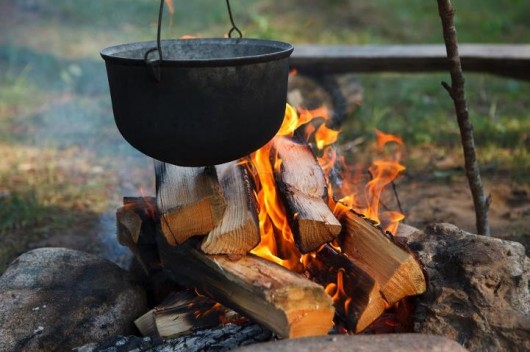 The classic image of the ‘Camp Fire’
The classic image of the ‘Camp Fire’
.
Australia’s tradition of the ‘Wood Fire’ is ecologically destructive
.
During Australia’s winter months, many in older homes habitually yearn for the warmth and glow of a traditional Wood Fire, and so utilise their open fire places and wood heaters. So habitually, upon the onset of winter people stock up on Firewood. It is a cultural yearning for the nostalgia of the Wood Fire – warm, earthy, dancing flames, flickering, spark spitting, the woodsmoke – we’ve all been there, it is tantalising and it feels right because it is natural – the ancient campfire tradition across humanity. In doing the Wood Fire ritual, we seek to rekindle our connection to Nature.
 The warmth and glow of a traditional Open Fire
…but the demand is driving deforestation of Ironbark Forests The warmth and glow of a traditional Open Fire
…but the demand is driving deforestation of Ironbark Forests
.
In earlier times when a few hundred of us settled in a given forest region, few forest resources were taken and so the forests replenished and seemed to cope. The forests were naturally resilient.
But as subsequent human hoards have invaded the land, and have bred and sprawled across the countryside in the hundreds of thousands, we have deforested entire forests in the process. These forests haven’t coped with the devastation. No forest could cope.
Australia’s native forests have been hacked, logged, burned and bulldozed into agrarian pasture to the horizon. Australia’s original blanket vegetation cover has been reduced to sad islands barely able to support wildlife habitat and in many cases causing extinctions – locally, regionally and nationally. All one needs do is a Google Earth search to appreciate the devastation on the natural landscape.
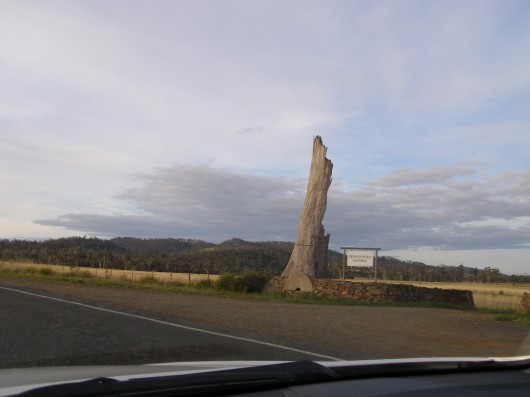 A legacy of forestry A legacy of forestry
.
Humanity’s sheer numbers and the encouraged consumption rate of Australians risk exacerbating the deforestation. Contemporary Australia is simply extending and perpetuating the old colonial exploitive mindset and a lifestyle reminiscent of 19th Century invading colonists.
The cultural heritage of the Wood Fire is necessarily contributing to this deforestation, particularly to Australia’s native Box-Ironbark Forests.
For Australians to continue to yearn for the glow, warmth and woodsmoke of the traditional Wood Fire now that we number in the hundreds of thousands, if not millions, and so the aggregate consumption of timber for firewood has simply become unsustainable. Our native forests have become too small and disparate to sustain wildlife breeding.
The few shrinking native forests that our forebears and their frenzied clearing have left us, simply are disappearing. Australia’s remnant native forests continue to be destroyed by us just to serve this selfish cultural yearning for earthy nostalgia of the Wood Fire. The same applies to all woodheaters.
 A classic wood fire in an old style open fireplace A classic wood fire in an old style open fireplace
.
The Australian Wood Fire cultural imperative through winter has become a driver of forest extinctions. There have become too many of us wanting tonnes of the forest to burn in our open fires and wood heaters, and too few forests left.
Australia’s firewood demand is driving deforestation. There is estimated to be around 800,000 wood heaters and 700,000 open fire places in Australia (ANZECC, 2001). There combined use is unsustainable and has got to stop! We need to question this inherited and habitual Open Fire/Woodheater culture and the devastating impact it is causing to our native forests.
.
“One of the hidden environmental issues affecting Australia’s woodlands, the collection of firewood, is starting to be revealed. CSIRO has prepared a report, Impact and Use of Firewood in Australia, pointing out alarming environmental problems.
For example, up to 6 million tonnes of fuelwood is consumed in Australia each year – double the amount of annual exports of eucalypt woodchips!”
[Source: ‘Firewood Conference’ in Armidale, NSW, May 2001, ^http://dazed.org/npa/npj/200102/FebYourNPA.htm]
.
Commercial Firewood is Forest ‘Eco-theft‘
.
Firewood taken from a native forest for personal use is one thing. The scale and severity of adverse impact upon forest ecology will vary according to the amount taken and the ecological sensitivity of the place it is taken from. Few domestic takers of firewood will be qualified ecologists and so will have no or little comprehension or respect for such impacts.
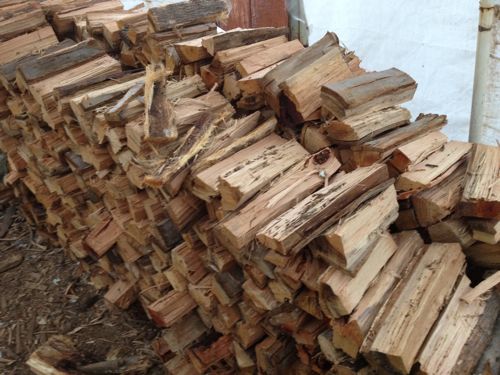 A private firewood stack A private firewood stack
.
According to the CSIRO, up to 5.5 million tonnes of timber is harvested annually for Australian domestic firewood use. When industrial firewood use is included, the total amount rises 20% to between 6-7 million tonnes. This weight is roughly double the amount of eucalypt currently exported annually from Australia as woodchips. About half of all domestic firewood is collected by the consumer and 84% of domestic firewood is collected on private property. [CSIRO, 2000]
Across Australia, access to State Forests is unfettered and the collecting of firewood for personal (domestic) consumption is an uncontrolled free-for-all, little improved from the exploitative mindset of Australia’s early and more ignorant colonists.
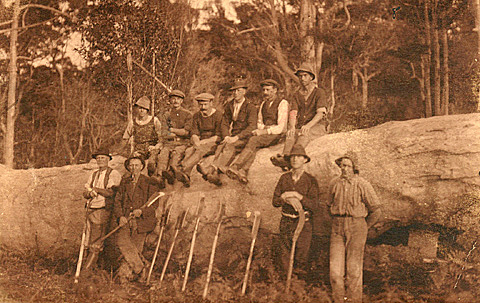 Australian colonial ‘progress’ Australian colonial ‘progress’
.
Deforestation by firewood taking is perhaps not as broadscale and well known as the Conservation Movement’s exposure of state-sanctioned Industrial Logging by the likes of Australian state government departments:
- ‘VicForests‘ (Victoria)
- ‘Forests NSW‘ (New South Wales)
- ‘Forestry SA‘ (South Australia)
- ‘Forestry Tasmania‘ (Tasmania)
- ‘Forests and Wood‘ (Queensland)
- ‘Forests Products Commission‘ (West Australia)
.
Or is it?
It is Australia’s Commercial Firewood Industry that contributes to the demise of Australia’s remnant native forests by its ‘death by a thousand cuts‘. Commercial Firewood entails the direct taking of wood from Australia’s native forests for commercial sale and profit. It is of a scale far greater than domestic forewood collecting, but where are the statistics kept and publicised by the Australian Government?
Just as demand for firewood drive supply, the artificial low economic cost of firewood encourages demand volume. Since firewood is sold a low cost, it competes favourably with jalternatiuve sources of fuel, such as gas and electricity, for domestic heating. Commercial firewood suppliers also deliberately appeal to the Wood Fire cultural image to encourage their firewood sales. Suppliers and consusmers thus feed off each other at low cost and high volumes, and so more native forests lose out.
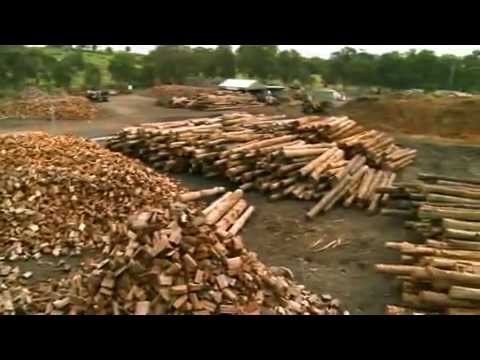 A commercial firewood stack A commercial firewood stack
.
The low or no cost availability of timber from State Forests Native timber means that the industry operates on an industrial scale taking vast quantities of timber, particularly from the preferred hardwood Box-Ironbark Forests and the like. The Commerical Firewood Industry is encouraged by the Australian Government and by all state governments, which ignore the practice as if Australia’s natuve forests are unlimited, as if it had no adverse ecological impact upon the forest ecologies, as if it didn’t matter, as if there were no tomorrow.
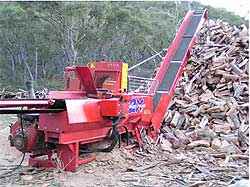 Commercial Firewood Production
Norwegian Hakki-Pilke industrial machinery enables an industrial scale operation
[Source: Mascus Australia, ^http://www.mascus.com.au/] Commercial Firewood Production
Norwegian Hakki-Pilke industrial machinery enables an industrial scale operation
[Source: Mascus Australia, ^http://www.mascus.com.au/]
.
Across Australia, each state government issues cheap permits for collecting firewood from State Forests.
This reflects:
- A cultural disregard for the values of Australia’s disappearing forest ecologies up to Prime Ministerial and Cabinet level
- The inadequacies of State laws to protect forest ecology
- An antiquainted colonist mindset persisting throughout the dominating Liberal and Labor parties.
.
The ecological impacts and the plethora of ecological advice and warnings about the destructive impacts of logging on forest ecology are being ignored. Australia’s Commercial Firewood Industry fuels demand for cheap firewood and in the process exacerbates Australia’s deforestation.
Australia’s Firewood Industry is unsustainable and has got to be nationally controlled. We need to challenge this exploitative industry and correct ignorant government policies. We need to find alternatives to the Wood Fire to stem the devastation of Australia’s remaining native forests and to help prevent more wildlife extinctions.
.
‘Forest Eco-theft’ involves the immoral taking of timber from a native forest, especially in large industrial quantities, for commercial gain and incurring no or little economic cost to the taker. The intended or actual use of the timber is irrelevent, but may include logs, firewood, craft timber, or woodchips. The greater the timber volume taken, the greater impact upon a forest and so the more serious the Eco-theft.
.
‘Eco-theft’ is only different to criminal theft because of the colonist exploitative mindset of current governments rejecting native forest having ecological value worthy of protection under the Crimes Act.
.
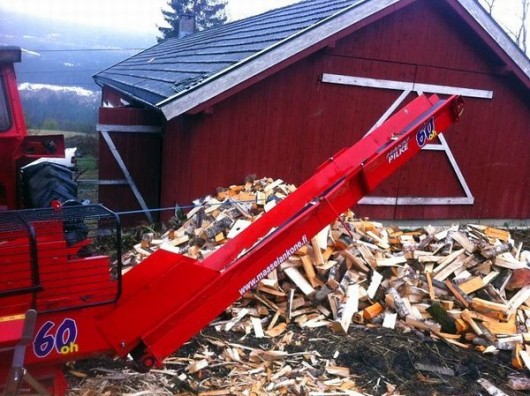 An industrial scale Hakki-Pilke firewood processor from Norway An industrial scale Hakki-Pilke firewood processor from Norway
.
Forest Eco-theft in an environment of dwindling forest habitat has become a key threatening process. At the current rate of Forest Eco-theft, Australia’s native forests fueling our pleasure for earthy glows and hearth warmth, will be gone.
Firewood Logging simply destroys forest habitat and contributes to the demise and local extinctions of threatened and endangered wildlife. Australia’s flora and fauna deaths and ultimate extinctions has become infamy – Australia currently has the worst record of mammalian extinctions on the planet, and the Firewood culture is contributing to it.
Many consumers of firewood either actively couldn’t care, or else passively turn an insular blind eye to the adverse ecological impacts of firewood harvesting. Our Australian Government ignores the firewood deforestation problem, avoiding it for party political convenience – immorally, irresponsibly and unrepresentingly.
Just as Poaching Wildlife is immoral, so too is Forest Eco-theft. Both these exploitative practices hark to colonial times and need to be banned.
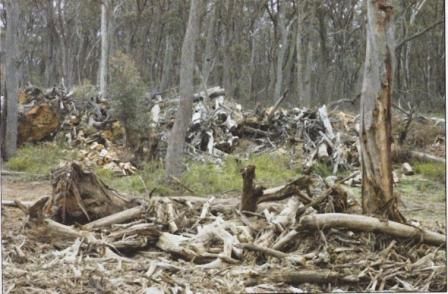 Firewood Logging of State Forest near Taralga NSW in 2006.
(along the Goulbourn-Oberon Road, just west of the Blue Mountains)
“This is in the habitat of Diuris aequalis. Had a fair result after two visits to this site and three submissions to local Council. Department of Environment and Conservation have imposed rigid conditions on this business.” Firewood Logging of State Forest near Taralga NSW in 2006.
(along the Goulbourn-Oberon Road, just west of the Blue Mountains)
“This is in the habitat of Diuris aequalis. Had a fair result after two visits to this site and three submissions to local Council. Department of Environment and Conservation have imposed rigid conditions on this business.”
[Source: ‘Habitat – Protection or Destruction‘, 2006, by Alan W Stephenson, Conservation Director, Australian Orchid Council Inc.
^http://www.orchidsaustralia.com/article_%20conservation_no3.htm]
.
.
Why choose ‘Ironbark Firewood’ ?
.
Why choose Ironbark Firewood ? Why not choose an alternative sources of fuel for home heating? Never thought to question the legitimacy of your fuel?
Here’s the justification by one firewood supplier as to why one should choose Ironbark Firewood:
- ‘Long Burning. Harder to start but will burn 6 – 8 hours. These timbers are the slowest growing and the hardest of all hardwoods.’
- ‘Very little ash. Clean out fire only once per season approximately.’
- ‘Strong Burning. Cannot be put out even if the vent closed, unless water is used.’
 A classic Ironbark ‘Open Fire’ A classic Ironbark ‘Open Fire’
.
The most common type of firewood commerically sold and promoted in the eastern Australian states is Ironbark Firewood. This is typically sourced from Box-Ironbark Forests (native grassy woodlands).
According to the Firewood Association of Australia (FAA), Ironbark and Box are the preferred firewood in Queensland, while in Victoria, southern NSW and South Australia, River Red Gum is preferred. Jarrah and Wandoo hardwood timbers are preferred in Western Australia, while in Tasmania, Brown Peppermint is considered the best firewood.
[Source: ^http://www.firewood.asn.au/faq.html]
.
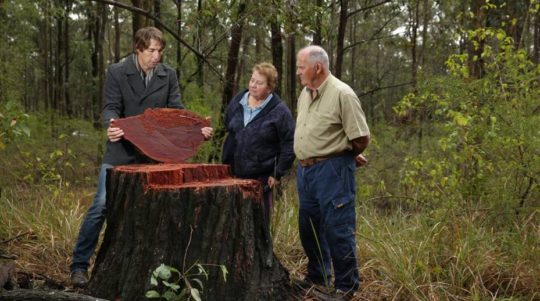 What the hell?
Old Growth cut up for cheap firewood? What the hell?
Old Growth cut up for cheap firewood?
[Source: “Environmental vandals” cut down 100-year-old trees on land at East Maitland, 20180905, by Donna Sharpe, ^https://www.beaudeserttimes.com.au/story/5629093/chainsaw-massacre-environmental-vandals-cut-down-100-year-old-trees/]
.
Sydney’s Firewood has been linked to ongoing Queensland land clearing, and in Queensland successive backward state governments have an ignoble reputation for land clearing like there’s no tomorrow.
Landclearing in Queensland has become the major supplier of Sydney’s quality firewood. Most of Sydney’s big firewood companies now rely on the Sunshine State for a significant proportion of ironbark and box logs – highly sought-after timbers because of their density. The National Parks Association says firewood from endangered Queensland woodlands is being used in homes across New South Wales.
Back in 2001, the National Parks Association of NSW called on the NSW Government to limit the State’s use of firewood following revelations that most of the wood sold by Sydney’s big firewood companies comes from clearing of Queenslands threatened Ironbark and Box woodlands.
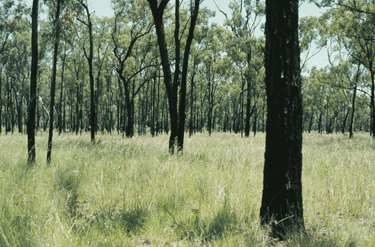 Ironbark Woodland of Central Queensland
[Australia Natural Resource Atlas] Ironbark Woodland of Central Queensland
[Australia Natural Resource Atlas]
.
At the time, Mr Charlie Spiteri, the owner of Betta Burn Firewood, one of the biggest suppliers in Sydney, refused to reveal how much firewood he supplies each year but estimates that the Sydney region, including Katoomba, consumes about 100,000 tonnes.
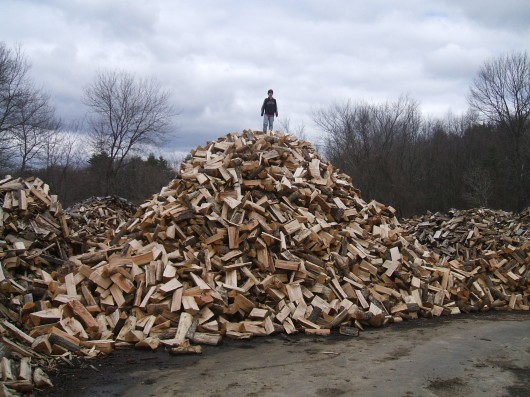 Commercial Firewood stockpile
(click photo to enlarge) Commercial Firewood stockpile
(click photo to enlarge)
.
Spiteri said about a third of his supply was sourced from Queensland, where the wood is worth between $40 and $50 a cubic metre. By the time the freight reaches Sydney, it is worth up to $125 and is being snapped up. “People are choosing ironbark and box and we have to go where the timber is,” Mr Spiteri said.
Other major sources of hardwoods for Betta Burn include the Pilliga State Forest in north-west NSW and private properties in the Nyngan area.
Executive officer at the National Parks Association (NSW), Mr Andrew Cox, said:
“Firewood collecting is the second largest threat to Australia’s temperate woodlands after land clearing. Now its being linked to landclearing!” “We know little about the impacts of firewood collecting and governments have been slow to take an interest. Most firewood consumers are unaware of where their wood comes from or the huge impact it has on threatened animals, birds and reptiles.”
“The firewood industry is large, but mostly unknown”, said Andrew Cox, NPA Executive Officer. “About 1,500,000 tonnes of firewood are used by New South Wales each year, exceeding the State’s yearly combined production of sawlogs and woodchips.”
“Firewood collecting targets slow-growing ecosystems and some of their most important components. Eucalypt species such as ironbark, box and red gum are the most favoured firewood sources.”
“We need to move away from the need to ‘clean-up’ a forest or woodland and instead look at dead wood as an important ecological component – just as important as the living trees.”
“Its because we’re not properly managing the woodlands that a wave of bird extinctions is underway in central NSW. More than 20 woodland dependent birds are declining from their former range and may become extinct in NSW. “It’s not ecologically sound, it’s not sustainable and there are serious impacts on birds, on animals that depend on the hollows.”
But no-one knows for sure how much timber salvaged from the bulldozed woodlands of Queensland is making its way south of the border in convoys of semi-trailers. Firewood collection operates in a legal vacuum – especially on private land – and virtually no figures are kept for where wood is sourced or how it is collected.
[Source: ‘Sydney’s Firewood Linked to Queensland Land Clearing‘, by Andrew Cox, Executive Officer, National Parks Association of NSW, 20010428, ^http://dazed.org/npa/press/20010428firewood.htm]
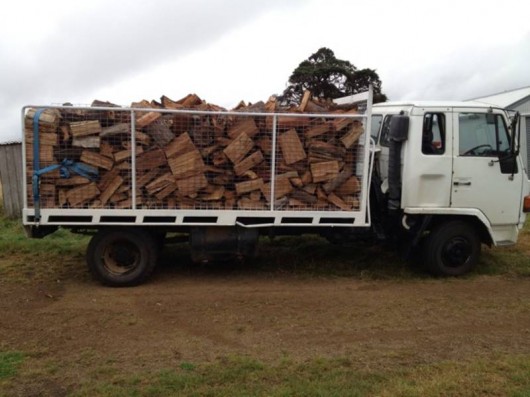 A typical commercial firewood truck – 2 tonne?
A typical commercial firewood truck – 2 tonne?
.
Since then, over a decade ago, what has changed? Anything? Nothing? Has the problem gotten worse?
.
83% of the original Box-Ironbark Forests have gone
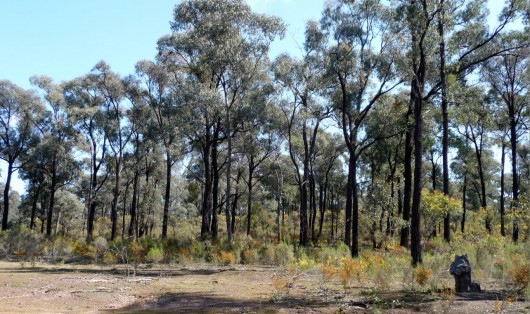 Box Ironbark forest in central Victoria dominated by Red Ironbark (Eucalyptus tricarpa)
Box Ironbark forest in central Victoria dominated by Red Ironbark (Eucalyptus tricarpa)
[Source: Ian Lunt’s Ecological Research Site, ^http://ianluntresearch.wordpress.com/2012/01/20/fire-and-rain-2-water-for-ironbarks/]
In Victoria, few forest and woodland ecosystems are as poorly represented in parks and reserves as the distinctive Box-Ironbark ecosystems of northern Victoria.
Since European settlement these forests and woodlands have been extensively cleared and fragmented for agriculture, urban development and gold mining, and cut for a variety of wood products. They once covered three million hectares of northern Victoria, but 83% of the original Box-Ironbark vegetation has now been cleared.
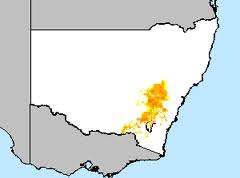 Original distribution of grassy woodlands across New South Wales
Original distribution of grassy woodlands across New South Wales
(Dominated by Box-Ironbark Forests)
.
Not only have the forests and woodlands been mostly cleared, but what is left is highly modified from its original structure and is also very fragmented. These remaining forests and woodlands are mostly on public land and these areas are ecologically important for a rich diversity of flora and fauna, many of which are rare or threatened.
Box-Ironbark forests and woodlands are highly accessible and the visitor is rewarded by a vibrant array of bird species, carpets of wildflowers in Spring, the rich aroma of eucalypt nectar, and many sites of historical and cultural interest. Despite their apparent uniformity, these forests actually have great diversity with around 1 500 species of higher plants and over 250 vertebrate species recorded in the region; many are largely restricted to Box-Ironbark forests and woodlands.
Some 297 Box-Ironbark plant species and 53 animal species are now classified as extinct, threatened or near-threatened. In addition, at least ten plant and animal species are known to have disappeared from the study area since the 1840s, and numerous others have become locally extinct. It is also clear and of great concern that many species, particularly birds, are known to be still declining.
Accordingly, a key feature of Box-Ironbark nature conservation is the promotion of ‘recovery’ for many species, rather than simply maintaining the status quo. Many Australian animals are dependent upon large, old eucalypt trees which contain the hollows required for shelter and breeding. At least six of the threatened Box-Ironbark fauna species are strongly dependent upon these trees. The massive loss of large old trees over the last 150 years is strongly implicated in the decline of these species and perhaps many others. It is therefore recommended that as well as protecting existing large old trees, additional measures be taken to ensure that there will, over time, be more large old trees in the forests.
[Source: ‘Box-Ironbark Forests & Woodlands Investigation‘, (Environment Conservation Council, 2001), Executive Summary, by The Victorian Environmental Assessment Council, 2001, ^http://www.veac.vic.gov.au/documents/385-Executive-Summary.pdf]
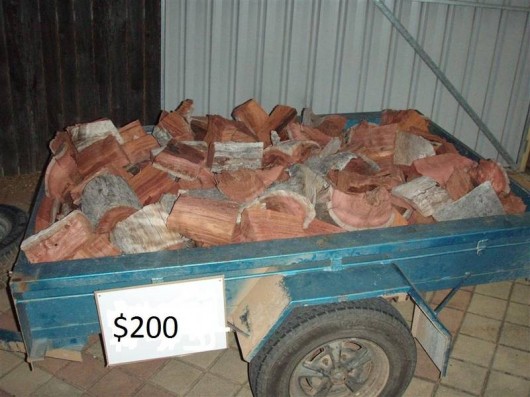 . .
‘Why is Firewood so cheap?
.
Ironbark is a preferred firewood in eastern Australia because it burns longer and hotter, so Australia’s native Ironbark forests continue to be logged for firewood.
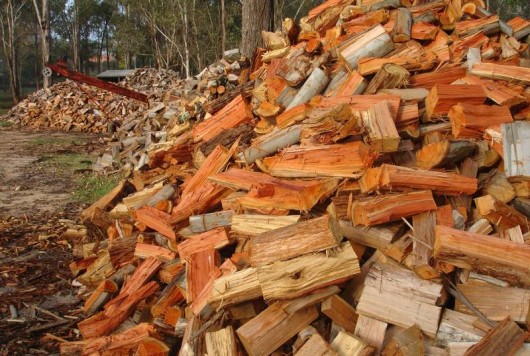 Ironbark firewood stack, commercially cut and split ready for domestic delivery Ironbark firewood stack, commercially cut and split ready for domestic delivery
.
The Australian hardwood timber industry now mainly relies upon plantation timbers and sustainable forestry management practices. Australian Ironbark Flooring retails at a premium price at typically over $80/m2 at 19mm thick. If that square meter of flooring was stacked one metre high to achieve a cubic metre, the calculated retail price for a cubic metre would be (1000m/19mm = 50 layers of flooring roughly, making the retail price for a cubic metre of Ironbark flooring around $80 x 50 = $5600/m3!
 Expensive Ironbark Flooring
Sourced from sustainable plantation timber, unaffordable to the Commercial Firewood Industry,
so firewood suppliers take the Ironbark out of State Forests instead.
[Source: Northern Rivers Timber, ^http://www.northernriverstimber.com.au/gallery.php] Expensive Ironbark Flooring
Sourced from sustainable plantation timber, unaffordable to the Commercial Firewood Industry,
so firewood suppliers take the Ironbark out of State Forests instead.
[Source: Northern Rivers Timber, ^http://www.northernriverstimber.com.au/gallery.php]
.
But commercial suppliers of firewood do not own plantation timber, nor do they buy their firewood from plantation timber growers. They certainly do not pay $5,600/m3 for firewood.
Commercial firewood is generally sold at considerable profit at under $160/m3, reducing in price according to volume purchased. Why would an commercial grower of plantation Ironbark hardwood sell the timber for firewood at $160/m3, when as flooring the typical market price is a factor of some 35 times greater at $5600/m3?
.
Commercial Firewood taken from native forests means that the $160 selling price is nearly all profit!
.
Australia’s commercial firewood instead is simply taken from Australia’s native hardwood forests. It is simply taken from State Forests at no cost to the commercial operator, except for a pultry token permit fee. That is why it is sold so cheaply.
This is why firewood remains a cheap affordable source for domestic household heating. But the cost is artifically economic and excludes the ecological cost.
How is this not Forest Eco-Theft? If the suppliers of Ironbark Firewood had to pay hardwood plantation owners a fair wholesale price for firewood, at such a high price their business model would be unviable. Firewood suppliers only exist because their business model relies upon firewood theft from dwindling State Forests, which continues to go unpoliced and ignored by the Australian Government.
 Industrial Firewood Industry Industrial Firewood Industry
.
Where do YOU get your FIREWOOD from?
.

- Where do you get your firewood from?
- Is it legal or eco-stolen?
- Is it accredited?
- What is Australia’s Firewood Industry doing to protect Australia’s long exploited and dwindling Ironbark Forests from firewood theft by firewood suppliers?
- What is the Australian Government doing to prevent firewood theft from State Forests?
- What is the Australian Government doing to monitor and control Australia’s firewood industry?
- Who in the Australian Government monitors the integrity and ecological protection of State Forests across New South Wales and indeed across Australia?
- Where is the ongoing review and analysis into the ecological health of Box-Ironbark Forests (Grassy Woodlands) across New South Wales and Victoria?
- Why are the statistics on firewood theft from State Forests not collected and publicised?
- Who polices and penalises deforestation of State Forests?
- How many people are caught and fined/gaoled for deforestation of State Forests
- Isn’t it illegal to steal firewood from State Forests – living trees or deadwood?
.
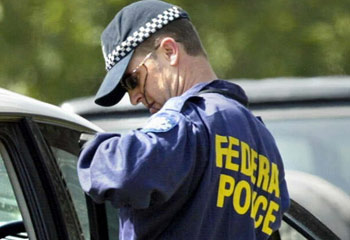
At the time of publication of this article, the New South Wales Government’s official website on Environment and specifically on Threatened Species reads:
“There has been a serious system failure on the threatened species website (www.threatenedspecies.nsw.gov.au) and it is no longer available”
[Source: ^http://www.environment.nsw.gov.au/threatenedspecies/]
.
 Pile of Ironbark Firewood cut and split ready for domestic delivery Pile of Ironbark Firewood cut and split ready for domestic delivery
.
In the Blue Mountains of New South Wales, the local newspaper advertises numerous suppliers of firewood, particularly at the onset of winter, and particularly promoting Ironbark Firewood as the premium product as follows:

Firewood suppliers advertising in the Blue Mountains Gazette, 20120516
.
But from where do these firewood suppliers source their firewood?
Not one of the above advertisements provides any proud statement about sourcing their wood ecologically responsibly, nor about being ecologically accredited. The default presumption thus is that none of these suppliers is environmentally responsible, nor accredited. So don’t buy from any of them!
Is the advertised firewood sourced illegally from Australia’s disappearing Box-Ironbark Forests, and so exacerbating the deforestation problem? How do we know it isn’t?
How simple is it for any common thief to buy a chainsaw, drive out to a patch of State Forest in a ute or in a truck or with a trailer in tow, then chainsaw several trees in a Box-Ironbark Forest, paying nothing for them, then flog the wood for personal profit? Too easy! Anyone can buy a chainsaw from a local garden tool supplier, even a kid. There are no chainsaw laws in Australia. It is treated like buying secateurs. Bunnings sells cheap chainsaws brand-new for just $200!
So armed with a trailer and chainsaw, a common thief has a lucrative business, one ignored by the Australian Government. With firewood retailing from $160/cubic metre, it is a nice little earner. This exploitative immoral trade in Ironbark Forest ecology is negligently condoned by the Australian Government and state governments.
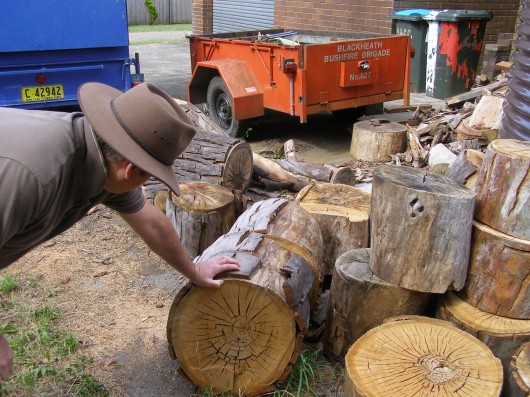 A native tree cut for firewood
A native tree cut for firewood
(Blackheath Fire Brigade, Rural Fire Service, Blue Mountains, November 2011)
.
‘Forest Eco-theft’ wiping out Ironbark Habitat
.
Logs have life inside
.
‘Collecting firewood is one of humankind’s oldest activities. Australians enjoy the beauty and warmth of a wood fire, and in many regional areas wood fires are the only practical source of heating.
Dead trees, often with hollows, make popular firewood as they are seasoned and burn well. But firewood collection comes at a cost to the environment, the consequences of which may not be entirely understood for years. Many firewood users are unaware of the ecological price of collecting dead trees and fallen logs. Often they mistakenly think they are just keeping the forest or farm tidy.
Firewood harvesting has an effect on our native woodlands, and a variety of threatened species. Dead standing and fallen timber provides crucial habitat for numerous species of animals and birds. It is now recognised that the removal of this wood for firewood is contributing to a significant loss of wildlife, particularly in the woodlands of south-eastern Australia. It is not just native animals that benefit from old wood left lying on the ground. This debris is valuable shelter for stock too. How many times have you found a newborn calf or lamb against an old log safe from the weather?
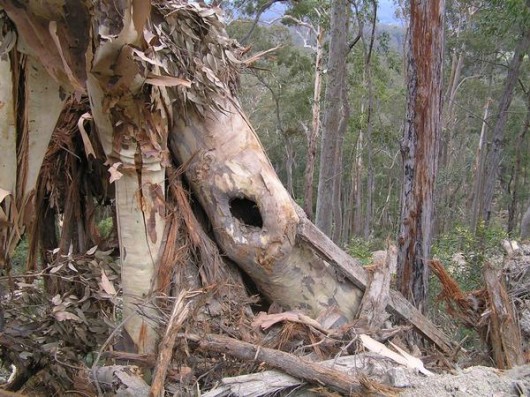 Habitat Tree of critical value to wildlife
…destroyed by Forestry NSW Habitat Tree of critical value to wildlife
…destroyed by Forestry NSW
.
Not only does standing and fallen dead wood provide important habitat for animals and birds, it also plays an essential role in maintaining forest and woodland nutrient cycles. Scientists from the CSIRO believe that dead wood is at least as important as living trees, fallen leaves and soil for the maintenance oif ecological processes sustaining biodiversity.’
[Source: ‘Are you burning their homes to warm yours?‘, a brochure questioning the dependency on firewood), by The National Heritage Trust. The Natural Heritage Trust (the Trust) was set up by the Australian Government under the Natural Heritage Trust Act 1997 to help restore and conserve Australia’s environment and natural resources. The Trust had three overarching objectives: (1) Biodiversity Conservation, (2) Sustainable Use of Natural Resources, and (3) Community Capacity Building and Institutional Change. The Natural Heritage Trust ceased on 30 June 2008. It has been replaced by Caring for our Country, but taking supplanting a natural heritage conservation philosophy with a more anthropocentric utilitarian ‘resource management’ philosopy, ^http://www.nrm.gov.au/]
.
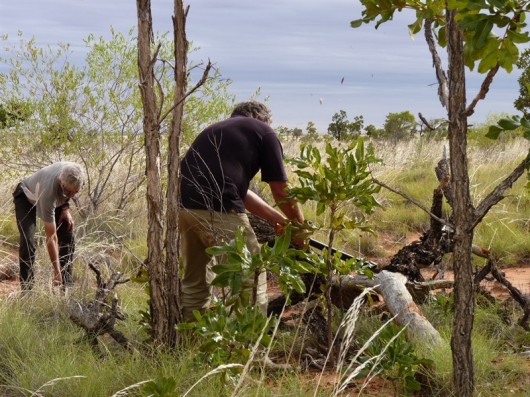 Cleaning up some messy dead timber – through whose eyes?
Nature is naturally ‘messy’
Cleaning up some messy dead timber – through whose eyes?
Nature is naturally ‘messy’
.
The Regent Honeyeater has become a ‘flagship species’ for conservation issues in the box-ironbark forest region of Victoria and New South Wales.
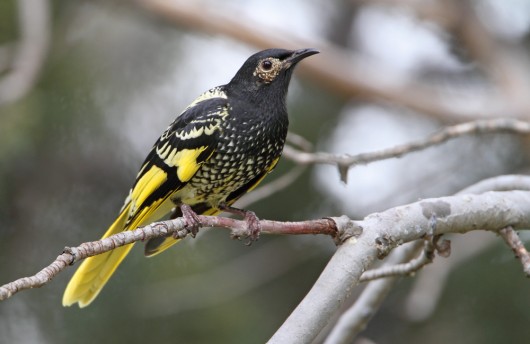 Regent Honeyeater (Anthochaera-phrygia)
Nationally listed as ‘Endangered‘.
Listed as endangered in Queensland and New South Wales, while in Victoria it is listed as threatened.
[Source: ^http://www.birdsinbackyards.net/species/Anthochaera-phrygia] Regent Honeyeater (Anthochaera-phrygia)
Nationally listed as ‘Endangered‘.
Listed as endangered in Queensland and New South Wales, while in Victoria it is listed as threatened.
[Source: ^http://www.birdsinbackyards.net/species/Anthochaera-phrygia]
.
Australia’s native Regent Honeyeater, was formerly more widely distributed in south-eastern mainland Australia from Rockhampton, Queensland to Adelaide, South Australia, but is now confined to Victoria and New South Wales, and is strongly associated with the western slopes of the Great Dividing Range. Its natural habitat is eucalypt forests and woodlands, including Box-Ironbark Forests.
The Regent Honeyeater has been badly affected by land-clearing, with the clearance of the most fertile stands of nectar-producing trees and the poor health of many remnants, as well as competition for nectar from other honeyeaters, being the major problems. Birds Australia is helping to conserve Regent Honeyeaters as part of its Woodland Birds for Biodiversity project.
[Source: Birds Australia, ^http://www.birdsinbackyards.net/species/Anthochaera-phrygia, and further references: ‘Field guide to the birds of Australia, 6th Edition’, ‘The Honeyeaters and their Allies of Australia’]
.
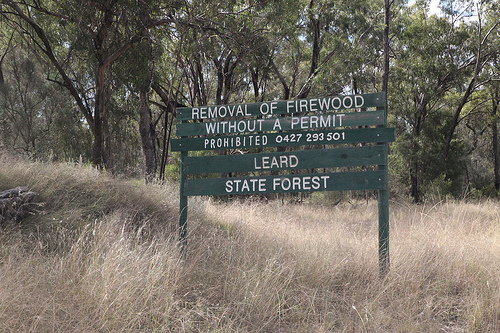 Leard State Forest Leadership
(New South Wales)
[Source: ^http://www.kateausburn.com/2012/04/10/leard-state-forest-next-frontier-of-the-coal-industry/] Leard State Forest Leadership
(New South Wales)
[Source: ^http://www.kateausburn.com/2012/04/10/leard-state-forest-next-frontier-of-the-coal-industry/]
.
Further Reading:
.
[1] ‘Box-Ironbark Forests & Woodlands Investigation‘, by The Environment Conservation Council, 2001) by The Victorian Environmental Assessment Council, Australia,^http://www.veac.vic.gov.au/investigation/box-ironbark-forests-woodlands-investigation-ecc-
‘This report contains the ECC’s recommendations for public land use in the Box-Ironbark area of northern Victoria, extending from Stawell to Wodonga. The recommendations incorporate those for parts of the LCC’s North Central, Murray Valley and adjoining areas.’ (>Read Report, PDF 6.6MB – large file may be slow to load)
.
[2] ‘ National Approach to Firewood Collection and Use in Australia‘ , June 2001, Australian and New Zealand Environment Conservation Council (ANZECC), Australia,^ http://www.environment.gov.au/land/publications/pubs/firewood-approach.pdf (> Read Report , PDF 990kb)
.
[3] ‘ Impact and Use of Firewood in Australia‘, by Don Driscoll, George Milkovits, David Freudenberger, CSIRO Sustainable Ecosystems, Australia,^ http://www.environment.gov.au/land/publications/pubs/firewood-impacts.pdf, (> Read Report, PDF 400kb)
.
Tags: Box Firewood, Box-Ironbark Forests, Brown Peppermint, classic camp fire, Commercial Firewood Industry, domestic firewood, Eco-theft, firewood, firewood collecting, Firewood Logging, Forest Eco-theft, forest ecology, grassy woodlands, industrial logging, Ironbark Firewood, ironbark forest, Ironbark Woodland, Jarrah Firewood, land clearing, native forests, open fire, Pilliga State Forest, Red Ironbark, Regent Honeyeater, River Red Gum Firewood, State Forest, Wandoo Firewood, wildlife extinctions, wood fire
Posted in Birds (Australian), Threats from Deforestation | 5 Comments »
Add this post to Del.icio.us - Digg
Saturday, August 6th, 2011
On August 6th, 2011 Tigerquoll on CanDoBetter.net stated:
 to know one’s fate to know one’s fate
.
Globalisation is evangelised as the modern religion of humanism. But dare criticise it and so invoke the blind wrath of SBS devotees, and be cast out, branded a facist racist and persecuted as if a 1692 Salem witch – burned at the stake!
.
Yet the demise of local values, endemic plants, endemic animals and traditional peoples are under barrage from the human pathogen. The torrent of human numbers, morphing influence and power out of the hands of incumbent local populations into the hands of the immigrant, who arrives, breeds, colonises and usurps. At least Julius Caesar left after he came, saw and conquered.
Every immigrant (alien) who steps off a plane, every introduced plant (weed), every introduced animal (feral) compounds the human pathogen against endemic species and peoples. Our 21st Century has the most humans ever. Climate change is not the problem.
.
Beachhead immigration in Australia has prevaded local society into becoming a preferred choice of Labor MPs.
It’s no different to VicForests logging Potoroo forest habitat throughout Victoria’s East Gippsland and then introducing sheep. Then there is the bizarre argument of one breed of ferals proclaiming more rights over that of another.
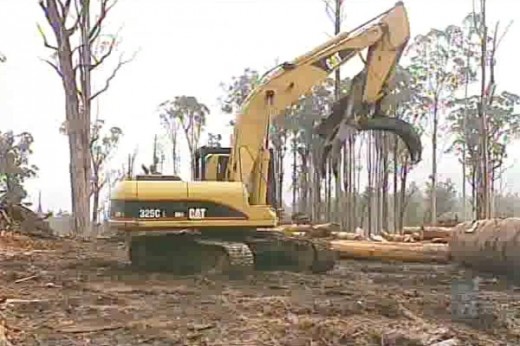 the absolute power of our species the absolute power of our species
.
.
Read the following article:
.
‘Deer culling attracts wild dogs’
[Source: ABC, Wednesday, 20110427, ^http://www.abc.net.au/rural/news/content/201104/s3201322.htm]
.
‘Wild dogs are encroaching closer into urban areas of Victoria’s east Gippsland.
Leo Hamilton, retired agronomist and 40-year landholder, has lost $1,000 worth of sheep to wild dogs in two months at his fine wool enterprise on the outskirts of Bairnsdale.
He says a formerly minor dog problem is escalating, as shooters try to control feral deer, and their fallen carcasses attract other pest animal predators.
“Sambar deer is not the sort of thing you throw in the back of the ute and cart off. You are talking 300-400 kilos of meat,” he said.
“And you talk to the truckies and the truckies have got the same problem. If they hit one on the road, it is two and half grand to fix the truck.”
Mr Hamilton says wild dogs were controlled in the past, but the behaviour of the large dogs has changed from shy killers for food, to aggressive and savage attacks that maim sheep.
“What is different about this attack is they are not predictable. In the past, the dog has come in and eaten the sheep, but these are unpredictable as they come in at any time, don’t eat the sheep, they mutilate the sheep, they just play with the sheep and maul them.”
Mr Hamilton says the culled feral pest deer weigh 300-400 kilogram, making them too heavy for shooters to remove.
“Their attitude is that they disaster in a couple of days…but they disappear in a couple of days because the wild dogs and foxes eat them.”
He says the wild dog problem is escalating and growing as the sambar deer population spreads to the outer urban areas.’
.
.
.
No mention of the indigenous Potoroo in all that. The controlling ferals are debating inter-feral rights, while the indigenous are ignored, forgotten…relegated to history’s underclass.
.
The terror of invasion. The defeat of a people and their cultural annihilation – resigned, racial hopelessness in the face of an invader’s genocidal ‘business as usual’.
.
Dominant sociopolitical dogma embraces, prescribes and propagates globalisation as global benefiting from cultural sharing and harmonisation of wealth, living standards and life expectancy. Hence AUSAID http://www.ausaid.gov.au/ is hell bent on parting Australia’s wealth to Third World prolific breeders of humanity.
.
But Globalisation erodes all labour industries in societies that have embraced human values of a safe, healthy and meaningful workplace to those backward sweatshop societies that couldn’t give a damn. This is why Australia’s unionised manufacturing which hard fought for OH&S standards has succumed to off-shoring who couldn’t give a damn about their workers.
Cheap products are human cheap, they dismiss human labour as ‘cheap’ – cheap in cost and cheap in value – cheap and nasty. 99% of all products sold in K-Mart are made in China, where cheap labour has supplanted Australia’s manufacturing base.
.
Globalised competition can force a ‘race to the bottom’ in wage rates and labour standards. Profit-imperative employers and government employer-sympathisers brand it euphemistcally ‘trade liberalisation’. Free enterprise in globalisation spares small operators no chance against the market might of multinationals. Only the big survive.
Indigenous and national culture and languages are being eroded by the modern globalised culture – the United States imposes Sarbanes Oxley on the rest of the planet who wish to trade with it.
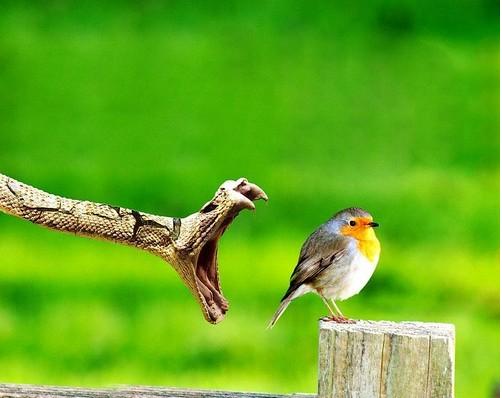 the tenet of globalisation the tenet of globalisation
.
Currently ecological conservation efforts are being made to deal with the rabbit population on Macquarie Island in a bid to save and restore the indigenous fauna populations and their habitat.
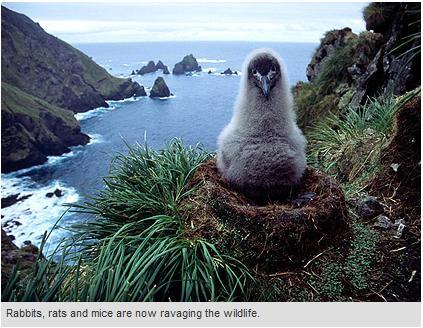 habitat reduced to islands habitat reduced to islands
.
Tigerquoll
Suggan Buggan
Snowy River Region
Victoria 3885
Australia
Tags: beachhead immigration, ferals, globalisation, habitat reduced to islands, human pathogen, humanism, indigenous, invasion, overpopulation, Potoroo, tenet of globalisation, the absolute power of our species, to know one's fate, wildlife extinctions
Posted in 34 Wildlife Conservation!, Threats from Colonising Species, Threats from Overpopulation, Wildlife | No Comments »
Add this post to Del.icio.us - Digg
Friday, January 28th, 2011
Australian native forests – are they valuable ecosystems and habitats for wildlife; or bushfire fuel hazards to be burned, before they burn?
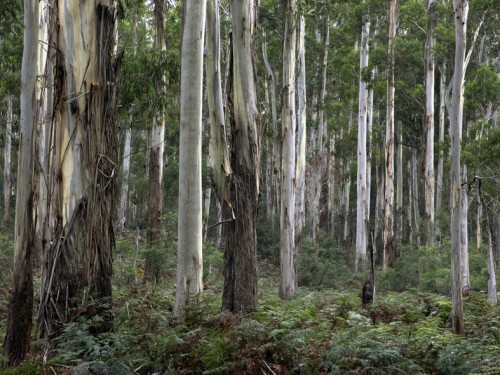 Blue Mountains wet schlerophyl forest
© Photo by Henry Gold, wilderness photographer
. Blue Mountains wet schlerophyl forest
© Photo by Henry Gold, wilderness photographer
.
.
Bushfire Management’s root problems
.
- Bushfire Management which recognises wildlife habitat as an asset worth protecting makes the fire fighting task immensely complex. So moreover the more simplistic and cost saving rationale of ‘protecting life and property’ holds sway, where no thought is given to the conservation values or to the habitat needs of wildlife. The inculcated and unquestioned bushfire management attitude that native forests are the cause of bushfires, rather than being victims of bushfires, belies one of the three key root problems of why bushfire management is failing. Ignitions left to burn in inaccessible terrain time again have proved be devastating not just for nature and wildlife, but consequentially for human life and property. Wildfire does not discriminate.
- Bushfire Management across Australia is so poorly equipped to detect and suppress ignitions when they do occur, that out of frustration, fear has been inculcated to encourage all native forests be dismissed as bushfire hazards and ‘prescribed burned’ as a precaution. Across the New South Wales Rural Fure Service, the term is quite unequivocal – ‘Hazard Reduction‘ . Broadscale hazard reduction, euphemistically labelled ‘strategic burns‘ or deceptively ‘ecological burns‘ and has become the greatest wildlife threatening process across Australia driving wildlife extinctions.’
- Both the localised and regional impacts of bushfire and hazard reduction upon wildlife ecology are not fully understood by the relevant sciences – ecology, biology and zoology. Fire ecology is still an emerging field. The Precautionary Principle is well acknowledged across these earth sciences, yet continues to be dismissed by bushfire management. They know not what they do, but I do not forgive them.
.
Australia’s record of wildlife extinctions are the worst of any country in the past two hundred years.
‘Of the forty mammal species known to have vanished in the world in the last 200 years, almost half have been Australian. Our continent has the worst record of mammal extinctions, with over 65 mammal species having vanished in the last 50 000 years.’ [Chris Johnson, James Cook University, 2006]
.
‘Australia leads the world in mammal extinctions. Over the last two hundred years 22 mammal species have become extinct, and over 100 are now on the threatened and endangered species list, compiled as part of the federal government’s Environment Protection and Biodiversity Conservation Act.’ [Professor Iain Gordon, research scientist in CSIRO’s new Biodiversity Theme, 2009.]
.
Uncontrolled bushfires, broadscale and frequent hazard reduction, and land clearing are the key drivers causing Australia’s remaining wildlife to disappear. Once habitat is destroyed, the landscape becomes favourable to feral predators which kill the remaining unprotected fauna. Thousands of hectares of Australia’s native forests are being burnt every year and are becoming sterile park lands devoid of undergrowth habitat. Wave after wave of habitat threats continue to undermine the layers of resilience of native fauna, until fauna simply have no defences left and populations become reduced to one local extinction after another.
James Woodford in his article ‘The dangers of fighting fire with fire‘ in the Sydney Morning Herald, 8th September 2008, incitefully observed:
‘Fighting fires with fear is a depressing annual event and easy sport on slow news days. Usually the debate fails to ask two crucial questions: does hazard reduction really do anything to save homes, and what’s the cost to native plants and animals caught in burn offs? What we do know is a lot of precious wild places are set on fire, in large part to keep happy those householders whose kitchen windows look out on gum trees.
Hazard reduction burning is flying scientifically blind. Much hazard reduction is performed to create a false sense of security rather than to reduce fire risks, and the effect on wildlife is virtually unknown. An annual bum conducted each year on Montague Island, near Narooma on the NSW far South Coast has become a ritual in which countless animals,including nesting penguins, are roasted.
The sooner we acknowledge this the sooner we can get on with the job of working out whether there is anything we can do to manage fires better. We need to know whether hazard reduction can be done without sending our wildlife down a path of firestick extinctions.’
.
.
‘Koalas may be extinct in seven years’
[Source: Sydney Morning Herald, 20070411]
.
‘Extreme drought, ferocious bushfires and urban development could make koalas extinct within seven years, environmentalists are warning. Alarms about the demise of the iconic and peculiar animal, which sleeps about 20 hours a day and eats only the leaves of the eucalyptus tree, have been raised before.
But Deborah Tabart, chief executive officer of the Australia Koala Foundation, believes the animal’s plight is as bad as she has seen it in her 20 years as a koala advocate.
“In South-East Queensland we had them listed as a vulnerable species which could go to extinction within 10 years. That could now be seven years,” she said. “The koala’s future is obviously bleak.”
South-East Queensland has the strongest koala populations in the vast country, meaning extinction in this area spells disaster for the future of the species, said Tabart.
The biggest threat is the loss of habitat due to road building and development on Australia’s east coast – traditional koala country. The joke, said Tabart, is that koalas enjoy good real estate and are often pushed out of their habitat by farming or development.
“I’ve driven pretty much the whole country and I just see environmental vandalism and destruction everywhere I go,” she said. “It’s a very sorry tale. There are [koala] management problems all over the country.”
Massive bushfires which raged in the country’s south for weeks during the summer, burning a million hectares of land, would also have killed thousands of koalas.’
[Read More]
.
.
‘A Bushfire action plan which protects people, property and nature’
[Source: The wilderness Society, 20090219, http://www.wilderness.org.au/campaigns/forests/bushfire-action-plan]
.
 In the immediate aftermath of the devastating Victorian Bushfires of 2009, The Wilderness Society, in response to bushfire management’s quick blaming of the native forests for the bushfires; drafted a ‘Bushfire Action Plan‘ that sought to recognise the need to protect nature along with people and their property. In the immediate aftermath of the devastating Victorian Bushfires of 2009, The Wilderness Society, in response to bushfire management’s quick blaming of the native forests for the bushfires; drafted a ‘Bushfire Action Plan‘ that sought to recognise the need to protect nature along with people and their property.
.
‘Bushfire remains one of the most complex and difficult aspects of our environment to deal with. Climate change is expected to make things even tougher, with increases in the number of high fire danger days and the number of people and houses at risk increasing with the tree/sea change phenomenon.
With the onset of climate change, mega-bushfires that burn massive areas are expected to occur more often.
A joint CSIRO and Bureau of Meteorology study of the impact of climate change in bushfires found parts of Victoria faced up to 65% more days of extreme fire risk by 2020, and 230% more by mid-century.
Yet clearly we have a lot to learn and the Royal Commission will set a new agenda for land and fire management, prevention and response. Many challenges will remain but some aspects seem clear. We need more money and support for fire fighters if we are to successfully protect life, property and the environment. Two key areas are the early detection of fires including the use of aerial surveillance and remote sensing especially in remote areas, increasing rapid response capacity including more “Elvis” helicopters to fight bushfires as soon as they start.
The outstanding work of firefighters on the front line needs to be backed up with the best available knowledge, planning and resources to ensure operations are as effective as possible in protecting people, property and nature. There is an urgent need to increase investment in these areas and rapidly establish scientific underpinning to fire management, as well as properly resourcing implementation and fire operations.
We also need more information for government and community about how to deliver fire management in a way that also protects the natural environment and our unique wildlife.
Fuel reduction burning has an important place in the fire management toolbox, and we support its place in scientifically underpinned fire management for the protection of life, property and the environment.
The issue of fuel reduction burning often dominates the fire debate, as if it is the only fire management tool. But it’s important to remember that this is only one tool in fire management, and not the silver bullet that will fire proof the landscape.
Environmental groups want to see the science that supports the current fuel reduction program, including a scientific justification for so-called hazard reduction burns in specific areas and the scientific justification for the route and extent of fire break establishment. Environmental groups are particularly concerned about the lack of impact assessment of these programs on biodiversity, particularly given their uncertain benefits to reduce the extent, frequency and severity of fire.
Views on these measures tend towards two extremes. One extreme is that we should fuel reduction burn all forest areas every 20 years and carve out thousands of kilometres of fire breaks, the other is that all our forests are wilderness areas which should just be allowed to burn and not manage our forests for fire at all.
For the Australian bush to be healthy and to protect people, property and nature we need a scientifically based balance between these extremes.
Fire management is not ‘one size fits all’ when it comes to the Australian bush. It needs to be targeted and specific, because we know that different kinds of bush respond differently to fire and therefore need different management. For native plants and animals to survive, fire management needs to promote “good” fire at the right time of year, of the right type and size. And that varies with vegetation type and resident native animals. Grasslands will require more frequent fires compared with forests, while areas such as rainforest will need to be protected from fire altogether.
That’s why we need good ecological science informing fire management, which has come a long way in understanding what’s best for native plants, but we need a better understanding of what fire management is best for protecting wildlife and avoiding extinctions. Its critical that scientists, fire agencies and governments work together to understand how to best manage fire to protect habitat for endangered wildlife, because no one wants fire management to lead to extinctions.
Of course, the protection of life & property needs to come first in fire management – but we can do that while also protecting nature and wildlife. A balanced approach is to prioritise the protection of life and property in areas close to farms and townships, and to prioritise fire management for the environment in remote areas and national parks.
A continuation of the expansion in knowledge, resources and support for fire management and community preparedness will best ensure the protection of life, property and the environment into the future…
.
We have developed a 6-point plan to reduce the bushfire risk and help protect people, property, wildlife and their habitat.
- Improve aerial surveillance to detect bushfires as soon as they start.
- Ramp up hi-tech, quick response capability, including more ‘Elvis’ helicopters to fight bushfires as soon as they ignite.
- More research into fire behaviour and the impact of fire on wildlife and their habitat.
- Around towns and urban areas – prioritise the protection of life and property with fuel reduction and fire break management plans.
- In remote areas and National Parks – prioritise the protection of wildlife and their habitat through scientifically-based fire management plans.
- Make native forests resistant to mega-fires by protecting old-growth forests, rainforests and water catchments from woodchipping and moving logging into existing plantations.
.
.
Critique of Roger Underwood’s Criticism of TWS ‘6-Point Plan‘
.
 On 12th February 2009, Roger Underwood, a former rural firefighter and a forestry industry employee in Western Australia, had his article published in The Australian newspaper criticising the above recommendations of The Wilderness Society (TWS). On 12th February 2009, Roger Underwood, a former rural firefighter and a forestry industry employee in Western Australia, had his article published in The Australian newspaper criticising the above recommendations of The Wilderness Society (TWS).
Regrettably, rather than offering constructive criticism and proposing counter arguments with supportive evidence, Underwood instead dismisses the Wilderness Society’s contribution, but disappointingly with empty rhetoric. Underwood states upfront:
“the trouble with the society’s action plan to reduce the risk of bushfires is that it won’t work.“
.
The Wilderness Society’s six-point action plan aims to counter the current bushfire management strategy that relies upon hazard reduction burning and the ecological damage this is causing – ‘destroying nature’, ‘pushing wildlife closer to extinction’, ‘increasing the fire risk to people and properties by making areas more fire prone’.
Underwood claims that statistics exist showing no massive increase in prescribed burning, but in fact that prescribed burning has declined. Yet Underwood fails to provide nor even reference any such statistics. He fails to recognise that both bushfires and prescribed burning collectively cause adverse impacts on wildlife. If all burning of native vegetation, however caused, is included in the assessment, then would statistics indeed show an increasing trend in the natural area affected by fire in Australia?
.
‘Burn it before it burns’ Theory
.
Underwood questions the wildlife extinction problem without any basis. He then adopts the ”old chestnut‘ theory of blaming the threat to wildlife on ‘killer bushfires‘. ‘Killer bushfires’ (the firestorm threat) has become the default justification by bushfire management for its policy of prescribed burning. This is the ‘Burn it before it burns!‘ defeatist attitude. If one burns the bush, there will be no bush to burn. Underwood’s claim that ‘killer bushfires’ are a “consequence of insufficient prescribed burning” is a self-serving slippery slope fallacy. If nature is an asset of value to be protected, then it is defeatist to damage it to prevent it from damage. The history of so-called ‘controlled burns‘ have an infamous reputation of getting out of control and becoming wildfires. If the attitude of burning as much of the bush as possible to avoid uncontrolled wildfire, then then paradoxically the implied incentive is to let controlled burns burn as much as possible to minimise the risk of unexpected fires in the same area.
.
In respect to each of The Wilderness Society’s (TWS) Six Point Plan, one counters Underwood’s responses as follows:
.
1: Improve aerial surveillance to detect bushfires as soon as they start
.
Underwood supports aerial detection as “a first-rate resource and a comprehensive system” but says that it can fail completely under hot, unstable atmospheric conditions and when there are very high winds. However, fire towers and aircraft are not the means of bushfire surveillance today. Low orbiting geostationary satellites with infrared and high resolution cameras can now spot individual cars in real time and through cloud and smoke. Satellites are not affected by atmospheric conditions such as high winds or hot temperatures. Modis-Fire is one company that specialises in such satellite technologies.
In addition, the CSIRO, with the Department of Defence and Geoscience Australia, has developed an internet-based satellite mapping system called ‘Sentinel Hotspots‘. Sentinel Hotspots gives emergency service managers access to the latest fire location information using satellite data. Fire fighting organisations across Australia have used this new strategic management tool, since it was launched in 2002, to identify and zoom in on fire hotspots. [Read More]
In 2003, an article in the International Journal of Wildland Fire entitled ‘Feasibility of forest-fire smoke detection using lidar‘ extolled the virtues of forest fire detection by smoke sensing with single-wavelength lidar.
Such technologies are available if the political will was met with appropriate investment. Such technologies could be available to a military-controlled national body, but unlikely to be available to volunteer members of the public. It all depends on the standard of performance Australians expect from bushfire management.
.
2: Ramp up hi-tech, quick response capability, including more ‘Elvis’ helicopters to fight bushfires as soon as they ignite.
.
Underwood dismisses aerial fire-bombing as a “dream” that “has never succeeded in Australia, and not even in the US” and “next to useless“.
Well, it seems Underwood is contradicted by the recent decisions of Australia State Governments across Australia’s eastern seaboard to charter not just one Erikson Aircrane but three. Not only was Elvis contracted from the United States in Summer 2010 to Victoria, “Elvis” was based in Essendon, ‘Marty‘ was based in Gippsland and ‘Elsie‘ was based in Ballarat. Clearly, the Victorian State Government considers the cost of these three aircraft justifiably cost-effective in offering quick response capability to fight bushfires.
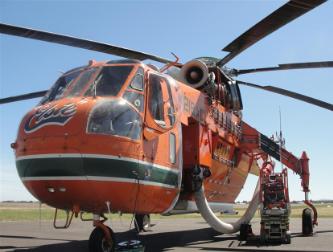 Dedicated Fire Fighting Erikson Aircrane ‘Elsie‘ based in Ballarat, Victoria during the 2010 Summer
© Photo ABC Ballarat http://www.abc.net.au/local/audio/2010/12/22/3099609.htm
.
In South Australia, the Country Fire Service (CFS) believes in the philosophy of hitting a fire ‘hard and fast’.
.
‘CFS volunteers and aerial firefighting aircraft are responded within minutes of a bushfire being reported and as many resources as possible are deployed to keep the fire small and reduce the chance of it getting out of control. It is not widely known that South Australia has a world class initial attack strategy of aerial firefighting. The value of a rapid aerial firefighting approach has been supported by Bushfire Cooperative Research Centre research. In their 2009 report titled ‘The cost-effectiveness of aerial fire fighting in Australia, the Research Centre wrote the following in their summary
.
The results of the analysis show that the use of ground resources with initial aerial support is the most economically efficient approach to fire suppression. Aircraft are economically efficient where they are able to reach and knock down a fire well before the ground crew arrives. This buys time for the ground forces to arrive and complete the containment. Rapid deployment of aerial suppression resources is important. This advantage is much greater in remote or otherwise inaccessible terrain. Where other suppression resources are unable to reach the fire event within a reasonable time period, sole use of aircraft is economically justified.’
[http://www.bushfirecrc.com.au/research/downloads/The-Cost-Effectiveness-of-Aerial-Fire-Fighting-in-Australia.pdf].
. Dedicated Fire Fighting Erikson Aircrane ‘Elsie‘ based in Ballarat, Victoria during the 2010 Summer
© Photo ABC Ballarat http://www.abc.net.au/local/audio/2010/12/22/3099609.htm
.
In South Australia, the Country Fire Service (CFS) believes in the philosophy of hitting a fire ‘hard and fast’.
.
‘CFS volunteers and aerial firefighting aircraft are responded within minutes of a bushfire being reported and as many resources as possible are deployed to keep the fire small and reduce the chance of it getting out of control. It is not widely known that South Australia has a world class initial attack strategy of aerial firefighting. The value of a rapid aerial firefighting approach has been supported by Bushfire Cooperative Research Centre research. In their 2009 report titled ‘The cost-effectiveness of aerial fire fighting in Australia, the Research Centre wrote the following in their summary
.
The results of the analysis show that the use of ground resources with initial aerial support is the most economically efficient approach to fire suppression. Aircraft are economically efficient where they are able to reach and knock down a fire well before the ground crew arrives. This buys time for the ground forces to arrive and complete the containment. Rapid deployment of aerial suppression resources is important. This advantage is much greater in remote or otherwise inaccessible terrain. Where other suppression resources are unable to reach the fire event within a reasonable time period, sole use of aircraft is economically justified.’
[http://www.bushfirecrc.com.au/research/downloads/The-Cost-Effectiveness-of-Aerial-Fire-Fighting-in-Australia.pdf].
.
Underwood claims that: “Elvis-type aircranes cost a fortune, burn massive amounts of fossil fuel, use gigalitres of precious water and are ineffective in stopping the run of a crown fire that is throwing spot fires. Water bombers do good work protecting houses from small grass fires. But against a big, hot forest fire and during night-time they are next to useless.”
Underwood conveys a sense of dogged reliance in traditional fire truck centric thinking as if to preserve an old firie culture of ‘we know best‘ and ‘nothing is going to change our thinking‘ mindset. May be it is out of petty envy wherein many volunteer firies can command trucks but wouldn’t have a clue flying helicopters and so would feel sidelined.
Well, since the 2009 Victorian Bushfires, more than A$50 million worth of new initiatives have been introduced or are under development.
“Further changes are likely to be introduced as the Royal Commission, which was established to investigate the Black Saturday disaster, is ongoing. Aerial firefighting is set to be addressed by the commission. Among new initiatives in Victoria is a A$10 million trial of a very large air tanker (VLAT) – the first-ever such experiment in the country. On 14 December, a McDonnell Douglas DC-10-30 Super Tanker, leased from US company 10 Tanker Air Carrier, arrived in Melbourne. Australian regulator, the Civil Aviation Safety Authority, and underwent final compliance assessment to allow it to enter service in January.”
.
[Source : http://www.flightglobal.com/articles/2010/02/09/338056/australia-puts-firefighting-tankers-to-the-test.html]
Underwood may well dismiss aerial suppression technology as ‘razzle-dazzle‘, but he is right to state that such investment requires governments to put more resources into research and into monitoring bushfire outcomes, including the environmental impacts of large, high-intensity bushfires and continuous feedback to management systems from real-world experience out in the forest.’
.
3: More research into fire behaviour and the impact of fire on wildlife and their habitat
.
While Underwood claims that he supports more research into fire behaviour and fire impacts, he is dismissive of the conclusions of much of the research already done, but offers no explanation. This seems an internal contradiction. What are the conclusions of the research?
Underwood claims the conclusions do not support the Wilderness Society’s agenda. How so? What is TWS agenda?
Underwood conveys an unsubstantiated bias against the Wilderness Society, only offering an ad hominem fallacious argument – attacking the messenger, not the argument.
.
The science on fire ecology is still emerging. The Wilderness Society validly states above that ‘bushfire remains one of the most complex and difficult aspects of our environment to deal with‘, that ‘there is an urgent need to increase investment in these areas and rapidly establish scientific underpinning to fire management, as well as properly resourcing implementation and fire operations‘ and ‘the lack of impact assessment of these programs on biodiversity, particularly given their uncertain benefits to reduce the extent, frequency and severity of fire‘.
.
4: Around towns and urban areas – prioritise the protection of life and property with fuel reduction and fire break management plans.
.
Underwood here perceives an inconsistency in TWS Action Plan – suggesting its support for fuel reduction around urban areas contradicts its claim that fuel reduction makes the burned areas “more fire prone”. However, this action item is about prioritising fuel reduction on a localised basis around the immediate areas where life and property are located.
Whereas broadscale hazard reduction that is carried out many miles from human settlements has become a new strategy of bushfire management. The excuse used is euphemistically termed a ‘strategic burn‘ or even an ‘ecological burn‘ in the name of encouraging biodiversity. Except that the practice seems to be a leftover habit from the Vietnam War in which helicopters are used to drop incendiaries indiscriminately into remote areas without any care for the consequences.
 A so-called ‘ecological burn‘ of Mt Cloudmaker
This was conducted by helicopter incendiary by NSW National Parks and Wildlife Service (DECCW)
in the remote Krungle Bungle Range of the Blue Mountains World Heritage Area
(Photo by editor from Hargraves Lookout, Shipley Plateau, 20080405 , free in public domain) A so-called ‘ecological burn‘ of Mt Cloudmaker
This was conducted by helicopter incendiary by NSW National Parks and Wildlife Service (DECCW)
in the remote Krungle Bungle Range of the Blue Mountains World Heritage Area
(Photo by editor from Hargraves Lookout, Shipley Plateau, 20080405 , free in public domain)
.
A recent example is the ‘strategic burn’ authorised and executed by the NSW Department of Environment, Climate Change and Water (DECCW) in the Blue Mountains World Heritage Area on 12th May 2010. Some 2500 hectares of remote wilderness was deliberately set alight around Massif Ridge, some 12 kilometres south of the town of Woodford in wild inaccessible forested area of the World Heritage Area. The excuse was to reduce the available ‘fuel’ (native vegetation) for potential future wildfires. [>Read More: ‘National Parks burning biodiversity‘ ]
.
5: In remote areas and National Parks – prioritise the protection of wildlife and their habitat through scientifically-based fire management plans.
.
Underwood contends another stock standard industry claim that where native forests have been protected, they have naturally accumulated fuel loads in which sooner or later an uncontrollable landscape-level fire occurs. So his anthropocentric theory runs that is humanity’s responsibility not to let nature be nature, but to control nature and so to burn the bush before it burns. This theory is premised on the defeatist approach that in the event of a bushfire, bushfire management is not in a position to detect and suppress it.
And so Underwood, poses the standard industry response of “more frequent planned burning under mild conditions“. He assumes that leaving the overstorey and the soil intact will ensures a diversity of habitat for wildlife. Yet Underwood is not a zoologist and has no understanding of the vital role that dense ground vegetation provides to Australia’s native ground dwelling mammals (e.g.the Long-footed Potoroo, Spotted-tailed quoll, Eastern Pygmy Possum, the Petrogale penicillata, Broad-toothed Rat, Bolam’s Mouse, the Smoky Mouse, the Eastern Chestnut Mouse, the Long-nosed Bandicoot), as well as nexting birds, flightless birds, amphibians and reptiles.
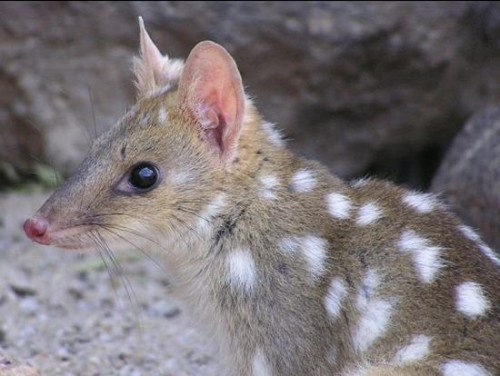 Eastern Quoll – Dasyurus viverrinus – EXTINCT on mainland Australia
© Photo by Andrea Little http://www.mtrothwell.com.au/gallery.html Eastern Quoll – Dasyurus viverrinus – EXTINCT on mainland Australia
© Photo by Andrea Little http://www.mtrothwell.com.au/gallery.html
.
Underwood’s view reflects the simplistic misguided view of biodiversity of most of Australia’s bushfire management – that the presence of trees and regrowth of fire-tolerant plants equates to biodiversity.
Can Underwood name one species of Australian fauna that is fire tolerant?
Underwood misinterprets the text of TWS which advocates an holistic fire management system, not as a silver bullet or ‘one-size-fits- all’ convenient panacea that pretends to fire proof the landscape. The only guarantee of ‘one-size-fits- all’ hazard recution is a sterile forest devoid of biodiversity and causing local species extinctions. TWS argues for a scientifically-based and balance approach recognising that some forest ecosystems like rainforests are most definitively fire-intolerant.
.
6: Make native forests resistant to mega-fires by protecting old-growth forests, rainforests and water catchments from woodchipping and moving logging into existing plantations
Underwood challenges this last item stating there is no evidence that old growth forest is less likely to burn than the regrowth forests. This is false. Australian native forests that regrow after fire are those that are fire-resistant. Typically, these genus (Eucalypt and Acacia) regrow quickly and become dense mono-cultures. If a fire passes through again, the fire is often more intense and devastating. Old growth forests, rainforests and riparian vegetation around water catchments tend to be moist and so less prone to bushfires.
But this sixth item is not about the relative propensity of old growth forests to burn more readily than regrowth forests, so Underwood’s argument is a distracting red herring. TWS’ aim here is more about placing a higher value on old growth and rainforests due to their greater biodiversity and due to their increasing scarcity. Clearly, TWS is ideologically opposed to woodchipping and logging of old growth forests and rainforests. Logging operations typically involve follow up deliberate burning and such fires have frequently got out of control. Underwood’s needling criticism of TWS for having a lack of knowledge of fire physics or bushfire experience is a typical defensive criticism leveled at anyone who dares to challenge bushfire management. Conversely, if Underwood has the prerequisite knowledge of fire physics or bushfire experience, he is not very forthcoming except to defend the status quo of bushfire management.
The recent bushfire results are demonstrating that bushfire management is increasingly unable to cope with bushfire catastrophes nor meet the expectations of the public to protect life, property and nature.
.
.
Further Reading:
.
[1] ‘Studies of the ground-dwelling mammals of eucalypt forests in south-eastern New South Wales: the species, their abundance and distribution‘ by PC Catling and RJ Burt, CSIRO, 1994, http://www.publish.csiro.au/paper/WR9940219.htm
.
[2] ‘Australia’s Mammal Extinctions – A 50,000-Year History‘, by Chris Johnson, 2006, James Cook University, North Queensland. http://www.cambridge.org/aus/catalogue/catalogue.asp?isbn=9780521686600
.
[3] ‘Solving Australia’s mammal extinction crisis‘, (2009) by Professor Iain Gordon, research scientist in CSIRO’s new Biodiversity Theme, ABC Science programme. He chaired a symposium on Australia’s mammal extinction crisis at the 10th International Congress of Ecology in Brisbane August 2009. http://www.abc.net.au/science/articles/2009/09/02/2674674.htm
.
[4] ‘Koalas may be extinct in seven years‘ , Sydney Morning Herald, 20070411, http://www.smh.com.au/news/environment/koalas-may-be-extinct-in-seven-years/2007/04/11/1175971155875.html
.
[5] ‘A Bushfire action plan which protects people, property and nature‘, The Wilderness Society, 20090219, http://www.wilderness.org.au/campaigns/forests/bushfire-action-plan
.
[6] ‘Manage bush better so climate won’t matter‘, by Roger Underwood (ex-firefighter), The Australian newspaper, 20090212, http://www.theaustralian.com.au/news/manage-bush-better-so-climate-wont-matter/story-e6frg73o-1111118824093
.
[7] ‘Locating bushfires as they happen‘, CSIRO – Sentinel Hotspots, http://www.csiro.au/solutions/Sentinel.html
.
[8] ‘Modis-Fire’ satellite bushfire detection, http://modis-fire.umd.edu/Active_Fire_Products.html
.
[9] ‘Elsie’s first day on the job, Ballarat’s fire fighting helicopter‘, by Prue Bentley (ABC TV Ballarat), 20101222, http://www.abc.net.au/local/audio/2010/12/22/3099609.htm
.
[10] ‘South Australia – Country Fire Service – Factors that influence aircraft selection‘ – http://www.cfs.sa.gov.au/site/about_us/aerial_firefighting/aircraft_selection.jsp
.
[11] ‘Australia puts firefighting tankers to the test‘, Fight Global 20090209, http://www.flightglobal.com/articles/2010/02/09/338056/australia-puts-firefighting-tankers-to-the-test.html
.
[12] ‘Bushfire-CRC – Aviation content’, http://www.bushfirecrc.com/category/bushfiretopic/aviation.
.
[13] ‘Towards New Information Tools for Understanding Bushfire Risk at the Urban Interface‘, 2004, R. Blanchi, J. Leonard, D. Maughan, Bushfire-CRC, CSIRO Manufacturing & Infrastructure Technology, Bushfire Research. [Read full report]
[end of article]
.
Tags: Australian native forests, Blue Mountains wildlife, broadscale burning, bushfire action plan, Bushfire-CRC, Chris Johnson, CSIRO, dangers of fighting fire with fire, eastern quoll, ecological burn, Erikson Aircrane, fire-intolerant, fuel reduction, fuel reduction program, ground dwelling mammals, hazard reduction, Henry Gold, koala extinction, mammal extinctions, Modis Fire, Montague Island hazard reduction, precautionary principle, precribed burning, Professor Iain Gordon, Roger Underwood, Rural Fire Service, Sentinel Hotspots, sterlisation of forests, strategic asset management, The Wilderness Society, threatening process, Victorian Bushfires 2009, wildfire, wildlife extinctions, wildlife habitat
Posted in Blue Mountains (AU), Threats from Bushfire | No Comments »
Add this post to Del.icio.us - Digg
|
|
 Orange-Bellied Parrot (Neophema chrysogaster)
Critically endangered and breeds only in Tasmania, Australia
[Source: Photo by John Harrison, in article ‘Threat of extinction demands fast and decisive action’, 20120724, by Tara Martin, published in The Conversation,
^http://theconversation.com/threat-of-extinction-demands-fast-and-decisive-action-7985]
Orange-Bellied Parrot (Neophema chrysogaster)
Critically endangered and breeds only in Tasmania, Australia
[Source: Photo by John Harrison, in article ‘Threat of extinction demands fast and decisive action’, 20120724, by Tara Martin, published in The Conversation,
^http://theconversation.com/threat-of-extinction-demands-fast-and-decisive-action-7985]
 Beverley Four Mile Uranium Mine
550km north east of Adelaide
Beverley Four Mile Uranium Mine
550km north east of Adelaide
 Australia’s recent Environment Ministers, respectively Peter Garrett and Tony Burke
Both Babyboomer Middle-Aged Men
Invariably in business, in politics, Babyboomer Middle-Aged Men
are the demographic drivers of ecological destruction across the planet.
Australia’s recent Environment Ministers, respectively Peter Garrett and Tony Burke
Both Babyboomer Middle-Aged Men
Invariably in business, in politics, Babyboomer Middle-Aged Men
are the demographic drivers of ecological destruction across the planet.
 The 100 tonne coal ship the ‘Shen Neng 1’ which went aground on 5th April 2010, while negotiating the Great Barrier Reef
The ship destroyed 3km of the coral Douglas Shoal which it “completely flattened” and “pulverised” marine life. The marine park authority’s chief scientist, Dr David Wachenfeld, expressed concerned also about the toxic heavy metal anti-fouling paint scraping off the hull.
[Source: ‘Three kilometres of Great Barrier Reef damage, 20 years to mend’, 20100414, by Tom Arup, The Age newspaper,
^http://www.theage.com.au/environment/three-kilometres-of-great-barrier-reef-damage-20-years-to-mend-20100413-s7p8.html]
The 100 tonne coal ship the ‘Shen Neng 1’ which went aground on 5th April 2010, while negotiating the Great Barrier Reef
The ship destroyed 3km of the coral Douglas Shoal which it “completely flattened” and “pulverised” marine life. The marine park authority’s chief scientist, Dr David Wachenfeld, expressed concerned also about the toxic heavy metal anti-fouling paint scraping off the hull.
[Source: ‘Three kilometres of Great Barrier Reef damage, 20 years to mend’, 20100414, by Tom Arup, The Age newspaper,
^http://www.theage.com.au/environment/three-kilometres-of-great-barrier-reef-damage-20-years-to-mend-20100413-s7p8.html]
 Tony Burke – the only grey haired Babyboomer in this photo
His demographic is responsible for the worst destruction of ecology across the Planet,
because the Nature-compromising values of males in this generation were formed when Nature was still considered plenty and its exploitation a God-given gospel.
Tony Burke’s values are wrong, inappropriate and his powerful decisions irreversible.
Tony Burke – the only grey haired Babyboomer in this photo
His demographic is responsible for the worst destruction of ecology across the Planet,
because the Nature-compromising values of males in this generation were formed when Nature was still considered plenty and its exploitation a God-given gospel.
Tony Burke’s values are wrong, inappropriate and his powerful decisions irreversible.
 On the brink of extinction: the Bridled Nailtail Wallaby
[Source: Photo by Kate Geraghty, Dead and dying: our great mammal crisis’, 20121117, by Tim Flannery, The Age newspaper,
^http://www.theage.com.au/national/dead-and-dying-our-great-mammal-crisis-20121116-29hi9.html]
On the brink of extinction: the Bridled Nailtail Wallaby
[Source: Photo by Kate Geraghty, Dead and dying: our great mammal crisis’, 20121117, by Tim Flannery, The Age newspaper,
^http://www.theage.com.au/national/dead-and-dying-our-great-mammal-crisis-20121116-29hi9.html]
 Species Extinction on Peter Garrett’s Watch
<< The Australian Government will invest $1.5 million to begin the rescue of Christmas Island’s ecosystem, including a mission to capture the last remaining Pipistrelle bats for captive breeding. “Volunteers and help from the Australasian Bat Society will be invaluable in this capture effort.” “My top priority now is to prevent any further extinctions and to restore the island’s environmental health,” Mr Garrett said.>>
A year later the critically endangered Christmas Island Pipistrelle (Pipistrellus murrayi) was declared extinct.
Species Extinction on Peter Garrett’s Watch
<< The Australian Government will invest $1.5 million to begin the rescue of Christmas Island’s ecosystem, including a mission to capture the last remaining Pipistrelle bats for captive breeding. “Volunteers and help from the Australasian Bat Society will be invaluable in this capture effort.” “My top priority now is to prevent any further extinctions and to restore the island’s environmental health,” Mr Garrett said.>>
A year later the critically endangered Christmas Island Pipistrelle (Pipistrellus murrayi) was declared extinct. Gilbert’s Potoroo – only 40 left
Gilbert’s Potoroo – only 40 left
 Southern Corroborree Frog (Pseudophryne corroboree)
Endemic to yet critically endangered in the Australian Alps.
Southern Corroborree Frog (Pseudophryne corroboree)
Endemic to yet critically endangered in the Australian Alps. Margaret River burrowing crayfish (Engaewa pseudoreducta)
[© Photo by Quinton Burham]
With only two known populations, the Margaret River burrowing crayfish is highly endangered.
Even one of these may no longer exist, as there have been no sightings since 1985.
The threats are almost all attributed to human activity.
Land clearing is the biggest danger, as crayfish habitat can be eroded or contaminated by farming, mining and urban development.
Feral pigs also damage habitat.
[Source: ^http://www.australiangeographic.com.au/journal/australias-most-endangered-species.htm]
Margaret River burrowing crayfish (Engaewa pseudoreducta)
[© Photo by Quinton Burham]
With only two known populations, the Margaret River burrowing crayfish is highly endangered.
Even one of these may no longer exist, as there have been no sightings since 1985.
The threats are almost all attributed to human activity.
Land clearing is the biggest danger, as crayfish habitat can be eroded or contaminated by farming, mining and urban development.
Feral pigs also damage habitat.
[Source: ^http://www.australiangeographic.com.au/journal/australias-most-endangered-species.htm]
 The classic image of the ‘Camp Fire’
The classic image of the ‘Camp Fire’
















































